Our incompetent officials are going to get us all toasted, while they sip champagne in protective luxury bunkers.
Yes. For certain.
Lets read what is actually going on. Shall we.
American officials believe they have, so far, succeeded at “boiling the frog” — increasing their military, intelligence and economic assistance to Ukraine step by step, without provoking Moscow into large-scale retaliation with any major single move.
Hum. Have they?
Well, keep the serfs dumbed down, poor, and controlled and then fill their minds with junk, while the wealthy continue to set up a throwback ruler / ruled society…
...income inequality in US & UK is so wide that while the richest are very well off, the poorest have a worse standard of living than the poorest in countries like Slovenia. Essentially, US & UK are poor societies with some very rich people. A thread:
Don’t you know…
Pilger: "In my lifetime, the United States has overthrown or attempted to overthrow more than 50 governments, mostly democracies. It has interfered in democratic elections in 30 countries. It has dropped bombs on the people of 30 countries, most of them poor and defenceless. It has attempted to murder the leaders of 50 countries. It has fought to suppress liberation movements in 20 countries." “best defined as follows: kiss my arse or I’ll kick your head in. It is as simple and as crude as that. What is interesting about it is that it’s so incredibly successful. It possesses the structures of disinformation, use of rhetoric, distortion of language, which are very persuasive, but are actually a pack of lies. It is very successful propaganda. They have the money, they have the technology, they have all the means to get away with it, and they do." “The crimes of the United States have been systematic, constant, vicious, remorseless, but very few people have actually talked about them. You have to hand it to America. It has exercised a quite clinical manipulation of power worldwide while masquerading as a force for universal good. It’s a brilliant, even witty, highly successful act of hypnosis.” ................. When I was a child, the word gay simply meant that person was happy. Like gay, the word democracy has been twisted beyond all extent of its original meaning. Posted by: Peter AU1 | Sep 18 2022 12:19 utc | 3
Ah. It’s called reality.
And big things are happening. Don’t ya know.
De-dollarization is a process, not an event. The biggest thing about the SCO meetings, to me, is that it is 100% clear that Russia is seeking to make NOPEC real - and furthermore to shift its exports from Europe to Asia. Not just China, but India and Pakistan. This is a huge deal. It will make Europe energy poor even as it turbocharges these low GDP per capita economies. And in the process, tie together Central Asia into a network of pipelines and natural gas (and oil) suppliers and consumers. This is a serious "Manifest Destiny" type of movement, especially when added Posted by: c1ue | Sep 18 2022 14:02 utc | 20
The SEO meeting was a gamechanger.
Is patience a virtue? Well, cooler heads are prevailing it appears. It’s a good thing that I’m not in government.
...as far as I am concerned, if it weren't for the incredible patience and prudence of V. Putin and S. Lavrov in particular, the collective Russian leadership would have already attacked all the command centers in Brussels and London with supersonic and hyper-sonic conventional weapons... or worse!... as co-belligerents in this war. These guys in D.C. are living proof in the extreme vanity, narrow-mindedness and viciousness of Empire, alienated and unconcerned with the real world consequences of their escalatory and inhumane actions. They are living in their bubble fantasy world; they haven't slow boiled the frog, it just hasn't happened yet that the Russian leadership has really taken off the gloves - but when they do......! Posted by: michaelj72 | Sep 18 2022 14:29 utc | 24
Don’t you know.
Other folk are seemingly getting with “the program”. Such as this quote…
China clearly believes Covid is a targeted bio weapon. They don't do unspeakable things to their citizens, They just practice their own form of disease control for when they have good reason to believe it is a dangerous pathogen.
About China
April 2022 China’s Global Security Initiative (hereafter referred to as “the Initiative”) for the first time. The Initiative champions commitments in six areas-
1) stay committed to the vision of common, comprehensive, cooperative and sustainable security, and work together to maintain world peace and security;
2) stay committed to respecting the sovereignty and territorial integrity of all countries, uphold non-interference in internal affairs, and respect the independent choices of development paths and social systems made by people in different countries;
3) stay committed to abiding by the purposes and principles of the UN Charter, reject the Cold War mentality, oppose unilateralism, and say no to group politics and bloc confrontation;
4) stay committed to taking the legitimate security concerns of all countries seriously, uphold the principle of indivisible security, build a balanced, effective and sustainable security architecture, and oppose the pursuit of one’s own security at the cost of others’ security;
5) stay committed to peacefully resolving differences and disputes between countries through dialogue and consultation, support all efforts conducive to the peaceful settlement of crises, reject double standards, and oppose the wanton use of unilateral sanctions and long-arm jurisdiction;
6) stay committed to maintaining security in both traditional and non-traditional domains, and work together on regional disputes and global challenges such as terrorism, climate change, cybersecurity and biosecurity.
by Ambassador Liu Yantao copied from HERE
Is persistent and continuous China bashing good for the US?
You know I used to believe all the China bashing. I used to think exactly what the American government and the mainstream media were saying about China.
The problem was that it got so frequent and in-your-face that eventually you either have to start questioning what’s being said, or you believe the stories so much that you essentially become stupid about it. Once that happens, you start really hating, and you can never see them as people; just something you have to get rid of because they are evil.
Essentially, you either eventually question or you eventually become the verry face of evil.
Just look at how many people want to punish, blockade, kill, and invade China. Why are these things even brought up?
Because they were fed so much China-bashing that all they know is to bash China. You can only bash what isn’t good. What isn’t good can be killed and destroyed.
That’s why such things exist as “China is curing cancer faster than anyone else in the world… but at what cost?”
“At what cost” is used to discredit even legitimately good things. We can’t even give them that when we even have a saying that curing cancer trumps all modern miracles. “He better be able to cure cancer!”
I remember a while ago there was a big hooha when the Huawei saga was underway and Americans went full-nuts over China potentially being able to gather American health data. The article’s thrust for why that was bad was because “China might be able to find cures to American health issues.”
I shit you not.
It’s terrible if China gets our health data because they might actually be able to find a cure for you. They wrote it in print that this was BAD!
We’re moving very close to war with China now; instigated by us, the American and western allies. People here have called me paranoid but I live in this region, and even Singapore’s top leaders can see where the winds are blowing.
The thing is that Deputy Prime Minister Wong isn’t wrong. Neither China nor the USA actually want a war, but the constant barrage of bashing leads to dehumanisation and hate, and poor calculus that may eventually lead to war regardless of intentions.
It’s not paranoia. It is basic human psychology.
Once you are able to dehumanize the Chinese, you can do anything against them… thinking you are perfectly within the right for doing so.
From the time this question was asked to now, we are much closer to war than ever.
Best Buddies
This is my 17 year old daughter. She has struggled since she was young with depression, anxiety, PTSD and a personality/mood disorder, and this is Whisper, her best friend, soulmate and therapy cat.

My daughter frequently tells us that Whisper absolutely without a doubt saved her life. But we all know she would give her life in a heartbeat to save her Whisper.
US life expectancy drops three years in only 18 months and we know why
You really have to be in a total state of denial about mRNA vax to not accept reality.
The last time a population had a 3-year drop in life expectancy in only 20 months (when they rolled out the jab) was maybe France in WWI, Russia in WWII or Europe during the Plague. It boggles the mind. China’s life expectancy is now higher than the US’s, while the US’s plunges from 77.1 to 76 years!
I respect everyone’s reasons for getting the mRNA gene treatment, including my family members.
It has been mentioned that those that have taken the mRNA need to now take daily supplements. I pray all of you are taking lots of Vitamins C & D, getting losts of air, using antioxidants and cell maintainers like turmeric+piperine, glutathion, zinc, magnesium, selenium and an anti-coagulant like a daily baby aspirin to prevent micro-clots.
GR is now keeping track of athletes’ deaths, read HERE
This has nothing to do with China. And everything to do with the United States.
Concerning COVID
Speaking as a statistician, one needs to look at all the important variables.
- Most importantly, China has universal healthcare.
- China has a high standard of care in its nursing homes.
- What percentage of elderly are concentrated in China’s nursing homes compared to the U.S.? A very small percentage.
- Did China storehouse COVID cases in vulnerable nursing homes?No, it did not.
- China also used highly effective early treatment with traditional Chinese medicine, according to PubMed.Both Western and Chinese medicines were used which greatly improved survival odds.
- China did not lock down the entire country, but apparently only its largest affected cities, which was about 25% of its total population, thus not totally disrupting their economy.(This goes completely against the Western narrative.)
- How did China count deaths: died from Covid vs. died with Covid. This is certainly different from the West; more exacting, and much more accurate.
- Did China bribe hospitals to report covid cases and death the way the West did?No, it did not.
- What test did China use to confirm Covid cases? It was a hard rule with double verification.
- What is the comparison of effectiveness and safety is the Chinese vaccine compared to the West’s vaccine? Yes, the “dead host” vaccine compared to the Western experimental mRNA injection.
- The first to get the vaccine in China were actual workers, not the elderly.
- How do excess deaths in China compare to the West? Small compared to HUGE.
Remember what Mark Twain said about statistics?
DWP wrote:
I think the most fundamental question is what was the origin of the virus.
Most likely is that it came from a lab, as Jeffrey Sachs and others have concluded.
Then that opens up a can of worms that are most important: why, when, where and who?
The “who” is most likely the U.S. as Sachs says.
Why?—was it a “blunder” as Sachs says or something more sinister.
Experts Warn US Is Falling Behind China in Key Technologies
Where were these “experts” for the last two decades?
At a gathering of current and former U.S. officials and private-sector executives Friday in Washington, concern was rampant that the United States has fallen behind China in the development of several key technologies, and that it faces an uncertain future in which other countries could challenge its historic dominance in the development of cutting-edge communications and computing technology.
Would you risk your life to save your cat from a house fire?
Of course without a doubt whatsoever.
I just couldn’t live with myself if i didn’t try to save her precious life, if that ever happened.
I would be so devastated if such a tragedy occurred and my cat was unfortunate enough to be stuck in a burning house.
I would run in so fast and definitely worth losing my own life because she is like my real family member.
How precious she is …

Has China destroyed the U.S. economy?
???
China hasn’t done anything to the US economy. The US is destroying its own economy…
- amassing a crushing $30 trillion national debt
- allowing its infrastructure to crumble and decay for decades
- letting its manufacturing go overseas
- spending trillions of dollars on useless wars
- failing to educate enough STEM graduates
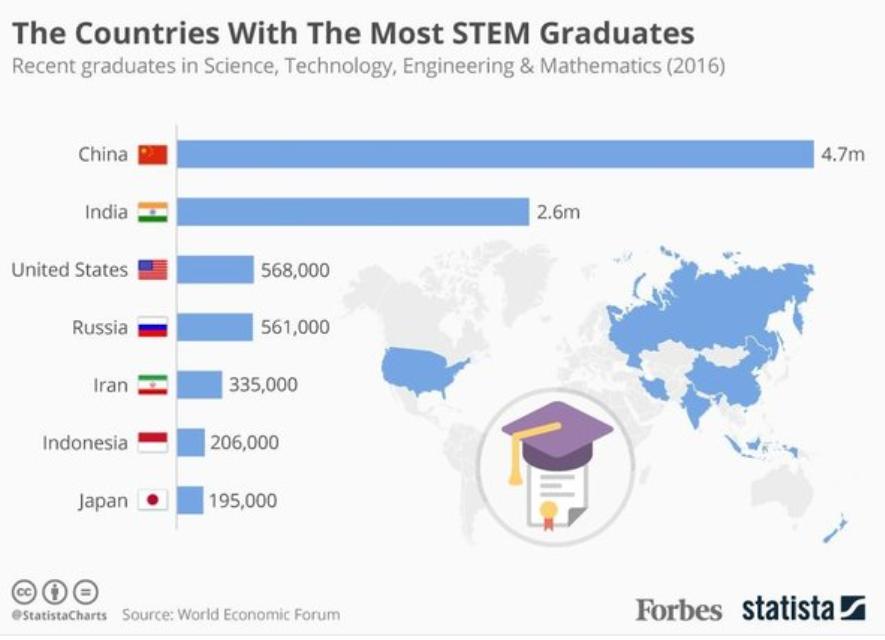
Aircraft titanium alloy
The rapid development of additive manufacturing technology, laser forming technology for large and complex integral components of aircraft titanium alloy, in China can manufacture high-performance, difficult-to-machine complex and integral key components of large aircraft. The world’s only breakthrough in laser rapid prototyping technology for aircraft titanium alloy large-scale main load-bearing structural parts is available in China.
China has mastered the core technology of the world’s leading 32-way high-end fault-tolerant computer used in information network core areas such as finance and telecommunications. The world class top technology and production share of high-end network routers are developed and made in China.
Chinese trust in the CCP
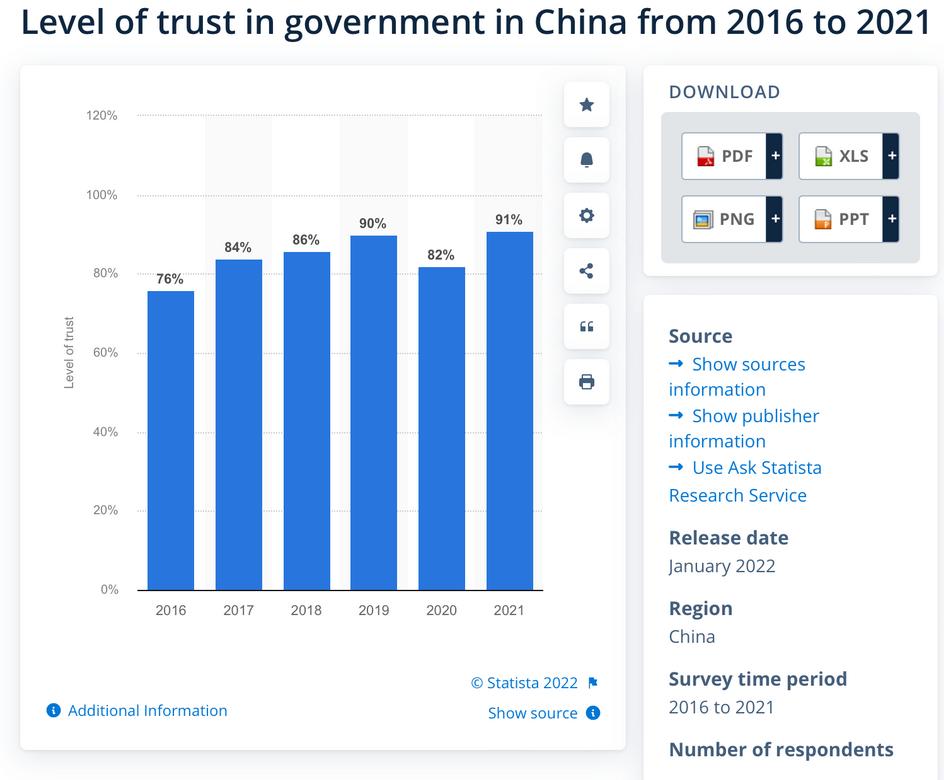
Have foreigners changed the way they think about China after visiting?
I completely changed my view of Chinese women.
Like many foreigners, I somehow believed that women in “the West” were more liberated than women in Asia. After moving to China, I experienced a kind of culture shock upon seeing large numbers of Chinese women in scientific fields and positions of leadership. At my host university, the new Communist Party secretary (an important post) was a woman in her thirties, i.e. quite young. I met more female engineers, physicists, and chemists in three years in China than I have during thirty years in the West. I even saw female workers doing road repair and hauling rocks in Yunnan, the kind of hard physical labor that is almost exclusively done by men in the West.
This is in spite of the unapologetic sexism that still exists among many Chinese people — like the guy from Tsinghua University who took me out on a date, only to tell me that he expected to make all the important decisions if we got married. Not to mention the fact that all of the country’s top leaders are men. Yet I quickly learned that Chinese women are not the shy, retiring flowers of western stereotypes, but strong and often outspoken.
For the first time in my life, I experienced what it was like to take it for granted that I would receive intellectual respect. I was occasionally disrespected for my ethnic origins or my perceived status, but no-one ever questioned my intelligence and ability to think rationally on the basis of my gender.
These experiences not only transformed my understanding of China, but also the way I viewed my culture of origin. I realized that progress is not linear. We are not more “advanced” than other nations. I also realized just how much unconscious sexism there is in western universities and workplaces, how normal it is for westerners to talk down to women as somehow less cogent than men. I came away from the experience with more confidence in my intellect and a greater respect for Chinese culture, humbled to realize that my assumptions were wrong.
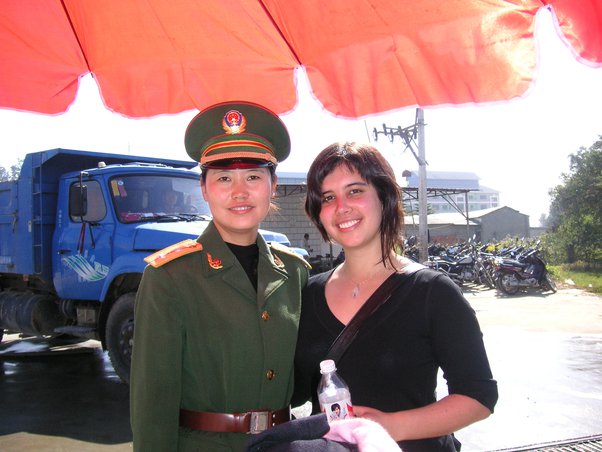
(Me with a Chinese soldier, 2006)
The satellite orbit change technology of China
The satellite orbit change technology of China is at the world’s leading level to extend the life of satellites. Satellites in space descend 100 meters every other day, and if they don’t change orbits, they will crash into the atmosphere and burn up. Satellites also have to dodge junk in space.
A Foreigners impression of China
Well, before I came here in China I was as brainwashed as any other foreigner having heard from what is being told by people who never had first hand experience of visiting China and the media hoax around the world.
However, once I stepped in here, my perception about China assuming they would have been living in subjugation, poverty and in many problems really changed.
What I noticed is Chinese are well disciplined, modest and hard working people who happen to be very nice to foreigners and seemed to serve me with great hospitality.
I realized China has developed so fast for the last 30 years, economy has increased, industrialisation is expanding and whatever we happen to see most likely to be coming from China.
They strive and do their best in almost every walk of life and the result today is in their favor letting Chinese people to have good life, better future with name and fame.
Today, there are more number of billionaires in China than USA, is all because of their dedication and punctuality towards their goal oriented life since they have learned a lot from their past.
The most important thing people around the world hold a presumed notion about, is that “whatever is made in China we instantly put forward judgemental comments as if China itself is the name of manufacturing low quality products”.
But reality is totally different, I have happened to see many kinds of quality products from electronics to garments and sewing needles to piece of a paper.
China is industrially widespread in all kinds of manufacturing products again depending on what you can afford.
Quality comes with price, pay the price, get the quality is straight forward thing that someone holding something in brain can understand for sure.
How come we expect good quality for something that is of $100 and you wish to get it for $10?
I think we should be thankful to China that based on our financial affordability range, they are making products to help us enjoy almost same benefits, which I believe no other country has balls to do with such a massive production for almost all kinds of things we use in our daily life.
Why the United States Has Set Itself Up for Failure in the Semiconductor Race for Military Supremacy
From HERE

Doomsday prophesising of how China’s days are numbered and that it is in the midst of an economic collapse could not be any further from reality.
The reasons for the spread of this sort of gossip is to keep up the belief (and thus investment) in the idea that the United States is secure in its alpha dog global status and that the world is better off siding with said alpha in its escalating and reckless, not to mention unnecessary, economic and geopolitical war against Russia and China. It is to intimidate any country foolish enough to throw too many of its eggs into the Russia-China basket with the thought that they will be left hanging in the wind once China collapses from the international stranglehold on its economy, which is touted as inevitable.
It is to convince the American people, that the further sacrifices they are about to make in their livelihood and standard of living will be worth it, perhaps to even go so far as to proclaim that this will be the necessary “new normal” all for the cause of world security, of course.
The reality of the situation which should be plain for everyone to see at this point, is that the United States’ sanctions and banning of various types of trade with Russia and China, meant to cripple their economies, is doing more damage to the world markets than anything else, including that of Europe and the United States.
These sanctions have brought the world into a very predictable energy and food crisis to which European and American citizens are told they must suffer through in the name of western security. A crisis which is gutting essential infrastructure required to sustain developed countries. A crisis from which there is no quick return to a first world living standard for its citizenry.
It was thought that such manoeuvres would cripple the Russian economy and cause internal unrest demanding for the removal of President Putin. Instead we see the Russian rouble stronger than it has ever been in large part due to the competent leadership of Sergei Glazyev (see his speech on Sanctions and Sovereignty) who is in the process of organising a “new economic order…[which] will involve a creation of a new digital payment currency founded through an international agreement based on principles of transparency, fairness, goodwill, and efficiency” as he explained in an interview with Pepe Escobar for The Cradle.
In other words, the world’s new monetary system, underpinned by a digital currency, will be backed by a basket of new foreign currencies and natural resources. And it will liberate the Global South from both western debt and IMF-induced austerity. What this means is that with this new system, the economic sovereignty of a nation will be protected; that a country rich in resources will finally be in a position to use the profits of these resources to strengthen their currencies and build infrastructure essential for any first world nation rather than be forcefully reduced to an indebted raw resource producer and nothing more as enforced by the policies of the IMF over the past several decades.
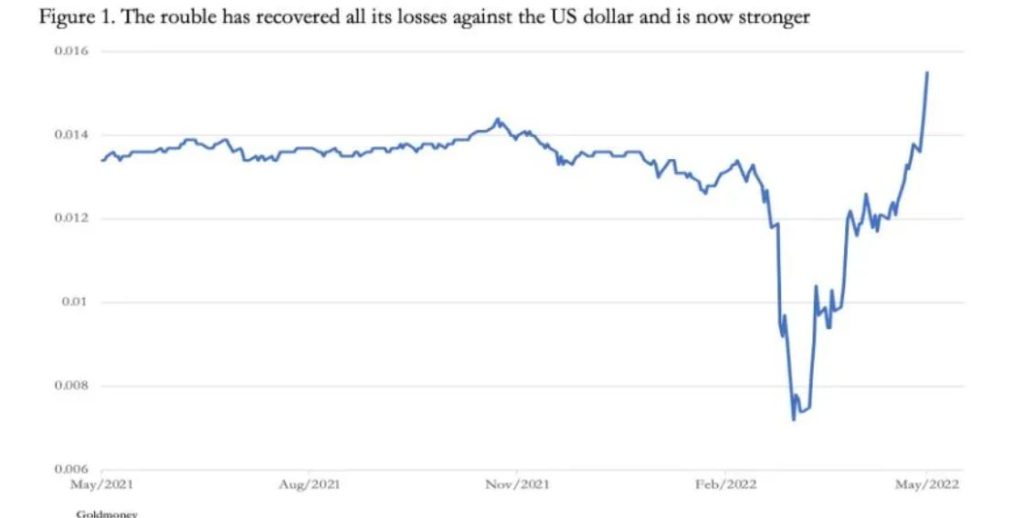
Russia’s economy did not tank, and the alliance between Russia and China has only grown stronger. And despite attempts to isolate their markets, trade opportunities remain ample and in high demand while the United States and Europe who refuse to participate in these markets are pushing themselves further into a corner.
Instead of reassessing its position, the U.S., which clearly did not expect such an outcome, has instead decided to escalate this economic war with China, which will create further hardship for the world markets, in the middle of a very serious semiconductor backlog.
Semiconductors/chips are an essential component for any smart device, including automobiles and smart phones. They are essential in the production of AI, quantum computing, and microelectronics.
Semiconductors are also essential for advanced weapons systems, including hypersonic missiles.
Interestingly, the United States has shot itself in its own kneecap in the middle of a race for military supremacy since the crisis of the semiconductor/chips backlog (triggered by the United States), which has heavily hit the consumer market especially the automobile industry, has also hit the United States’ ability to churn out advanced weapons systems in mass quantity.
In December 2020, SMIC along with other Chinese firms were put on a U.S. blacklist for exports called the Entity List. This was an attempt to prevent SMIC, China’s largest and most sophisticated semiconductor producer, from importing the necessary material and equipment to manufacture 14nm and 20nm semiconductors/chips, which also ended up cutting off the world markets from China, the main supplier of these chips.
TSMC (Taiwan) and Samsung (South Korea) are the present titans in the cutting-edge semiconductor industry (that is 7nm and 5nm chips), however, China’s SMIC was the largest supplier of 20nm+ chips which are essential for the consumer market. When China was taken out of this market it created a bottleneck since TSMC and Samsung, who do not specialise in bulk manufacturing of lower grade chips, were already way above capacity. This created a massive global bottleneck in semiconductor/chip production. [East Asia is manufacturing about 75% of the chips in the world.]
Ironically, the United States would have had an easier time amping up production in their advanced weapons systems if they had left China as the main global supplier of 20nm chips.
Over the past month or so the U.S. State Department has been busy setting up weapon sales with countries such as Japan ($293 million deal, principally with Raytheon Technologies for 150 air-to-air missiles that can be loaded on F-35 fighters), Singapore ($630 million deal for laser-guided bombs and other munitions), Australia ($235 million deal with Lockheed Martin for 80 air-to-surface missiles), South Korea ($130 million for 31 lightweight torpedoes to use with MH-60R helicopters for anti-submarine warfare) and Germany (with a potential sale of over 35 F-35 fighters).
These are orders that presently are unable to be fulfilled by these companies in the short-term due to the semiconductor backlog of 1-2 years or more.
The United States is attempting to increase its onshore manufacturing capabilities so that it can control much more of the supply chain within its domestic market, rather than the present reality, which is that there are several countries dispersed throughout the world who are the specialised leaders of one of the approximately 50 steps, requiring high standard specialisation, in manufacturing cutting edge semiconductors.
The specialising process for all the components required for leading chip manufacturing is so costly (in the hundreds of billions) and precise that it is estimated that it would take at least 4-6 years or more to master each area of specialisation.
“If you want a resilient [self-sufficient] chip supply chain, you not only need chip plants, you also need a whole string of suppliers from critical chemicals and precision components all coming along,” said an executive at Japan’s Daikin, reported by NIKKEI Asia. “Building a semiconductor plant takes several years, but building chemical plants will take even longer given the extensive environmental assessments and regulations for handling chemicals.” [Refer here for a short video on how semiconductors are made.]
Presently, no country comes even close to this capability. Later on in this paper I will explain why if any country is to reach resilience, that is self-sufficiency in this market, it will be China not the United States.
The American Medical System
On Saturday night in June of 2019, I was just about to fall asleep in my bed when I woke up unable to breathe. My husband was away on a business trip so I called my sister to come help me. My 15 year old called EMS as I started having seizures.
Fortunately for me, a wise paramedic insisted that I was taken to UMASS Worcester as the hospital has a neurology department with surgeons. I had an MRI on Sunday morning thanks to the dedicated nursing staff that insisted I get in the queue ahead of scheduled patients. A large mass was found in my brain. It needed to be removed as the seizures were a warning sign that my brain was struggling. The difficulty breathing was believed to be a result of prior seizures that caused me to aspirate spit into my lungs were it progressed into pneumonia. I had to be healed from the pneumonia before the craniotomy could happen. I was admitted to the ICU.
I was 51 at the time working at as VP at a very large bank. I was the bread winner in the family with a good salary, a decent bonus, and full benefits including private health insurance. I did not skimp on the insurance plan I selected. I had no signs of disease beforehand and had completed a dual Masters in Finance and an MBA at Northeastern the summer before.
The neurosurgeon that I agreed to do my craniotomy with, had a difficult conversation with my husband because the after effects of the seizures and pneumonia left me weak. During the procedure, the surgeon could have guidance from equipment that would prevent damage to critical parts of my brain. The surgeon also knew most American insurance doesn’t cover the cost. My husband agreed to pay the extra $17,000 to make sure I could walk, talk, and be my old self eventually.
The pneumonia was healed with antibiotics and I was scheduled for the craniotomy on the Wednesday after the discovery of the mass. The surgery took all day. Apparently I sat up the first night post-surgery although I don’t remember it. By the next day I was able to get into a chair with help, sit, talk, and thankfully recognize my children. The surgery in my opinion is a true miracle of modern medicine. The surgeon got 92% of the mass out.
The private insurance company denied coverage for the $17,000 charge for technology that kept my brain function nearly intact. The denial was because it was determined not medically necessary to preserve brain function in a 51 year old working-mother. I guess alive is the standard of care.
The mass was analyzed and was determined to be brain cancer, a grade 2 astrocytoma. I needed radiation to destroy the remaining 8% of the cancer tumor. I was told at Mass General that traditional photon radiation would cause necrosis to brain tissue and that an alternative called proton would preserve more healthy brain tissue. I wanted to preserve my brain so I could be a mother, wife, and maybe even go back to work.
Insurance once again interfered in quality of life decisions. Proton therapy was denied as not proven to be superior to photon radiation. I was also shocked at the cost of chemo drugs in USA even with insurance. Private insurance is a scam and is inhumane as it doesn’t consider quality of life.
Medicare covers proton therapy yet private insurance is able to deny coverage in the USA. Why are prostates in America worth coverage in elderly men and healthy brain tissue in a middle-aged woman is not covered? A functioning elderly penis is more important in my culture that a functioning middle-aged parent. How can some Americans get access to better care via Medicare while working middle-aged people get ripped off by private insurance if they become sick?
I did get the proton radiation yet I had to leave the United States to get it and depend on my husband’s country. I am lucky to have married a good man that opened up his country’s healthcare when I needed it most and was willing to pay the $17,000 insurance did not cover.
I am more scared about American healthcare than bitter. I am grateful for the hard-working nurses and doctors that saved my life yet I fear they are just chess pieces in the game. What will happen to the future generations of Americans if healthcare isn’t made more equitable? Why aren’t the insurance companies required to cover the same standard of care as Medicare?
Beef Burritos
Enjoy these hearty beef burritos for dinner – ready in 30 minutes. Perfect if you love Mexican cuisine.

Ingredients
- 2 cups shredded cooked beef
- 1 cup from one can (16 oz) Old El Paso™ Traditional Refried Beans
- 8 flour tortillas (10 inch)
- 2 cups shredded lettuce
- 2 medium tomatoes, chopped (1 1/2 cups)
- 1 cup shredded Cheddar cheese (4 oz)

Is China too far behind to catch up?
There has been a lot of persistence, perhaps in the belief that if one repeats something out loud enough times it will come true, that China is too far behind to be a contender in the semiconductor race. Since the U.S. ban on China purchasing certain essential materials for chip manufacturing in December 2020, in just the past year, China has experienced a 33% semiconductor growth output.
According to Bloomberg, China’s chip industry is the fastest growing anywhere else in the world, including the world leaders TSMC and Samsung, owning 19 out of the world’s 20 fastest growing chip industry firms over the past four quarters.
SMIC and Hua Hong Semiconductor Ltd., the biggest contract chip makers, have kept their Shanghai-based plants operating at almost full capacity even as the worst Covid-19 outbreak since 2020 paralyzed factories and logistics across China, while other leading semiconductor industries, such as TSMC and Samsung, have been operating at 60% capacity or lower (due to the backlog in essential materials). SMIC recently reported a 67% surge in quarterly sales, outpacing far larger rivals GlobalFoundries Inc. and TSMC.
Despite the United States having already pushed the Netherlands to ban ASML Holding NV from selling China EUV technology (considered essential for manufacturing cutting edge semiconductors), at the time of writing this, it is now attempting to put further pressure on the Netherlands to ban even DUV systems (which predate EUV and are generations behind cutting edge lithography technology) to China in the U.S.’ desperate attempt to remove or at least contain China as a competitor. The U.S. has also attempted to put pressure on Japan’s Nikon (the only other DUV manufacturer at 5% market share) as well.
However, Dutch Prime Minister Mark Rutte said this past June he is against reconsidering trade relations with China and called for the EU to develop its own policies toward Beijing. China is the Netherlands’ third-biggest trade partner after Germany and Belgium. ASML opposes a ban on sales of DUV lithography equipment to Chinese customers because it is already a mature technology.
I suspect this sort of response will become the new normal for the United States if they continue along this line of thinking that everyone, and not just the U.S., should also be ready to shoot themselves in the kneecap or worse, in service of a self-sabotaing idea of U.S. hegemony.
You have to admit, it is a hard story to sell when China is increasingly one of the top trading partners of the majority of countries, while the U.S. seems to only ask that countries be willing to do frequent bloodlettings and be the first to poke their heads up from the trenches in reckless military posturing, all in service to the Anglo-American empire, who has consistently shown that they have not a care in the world for the future state of such countries.
And it gets much worse for American aspirations for global military supremacy…
China’s SMIC has had the capability of manufacturing 7nm chips since 2021, thought to be equivalent to Taiwan’s TSMC’s N7 (7nm chip) in yield optimization. [TSMC is capable of 5nm chip production and is expected to achieve 3nm chip production by the end of this year]. This puts China in the lead of the United States’ Intel, which has yet to achieve manufacturing capability of 7nm chips and hopes to reach capability by the end of 2022 or early 2023.
[Note: Presently, TSMC is banned from selling semiconductors to Huawei that have been made with U.S. technology. Huawei up until that point was the biggest client of TSMC.]TSMC had already filed lawsuits in U.S. courts against SMIC for products made with TSMC trade secrets in 2003 and 2006, the latter which ended with a settlement. This was a rather controversial manoeuvre on the part of TSMC since the United States is not neutral ground and stands to benefit greatly by crippling what is now China’s no. 1 semiconductor producer. However, TSMC did decide to make a settlement with SMIC rather than attempting to go for the full jugular. Interestingly one of the terms of settlement was the transfer over of about 10% of SMIC’s stocks to TSMC.
There are no signs yet that TSMC is seeking another lawsuit against SMIC, however, even if they were successful, it were likely that China would be prevented from trading with unfriendly countries in 7nm chips but would continue its production and application within China and its trade to friendly countries. The U.S. is increasingly in no position to enforce anything further than this.
With the advent of SMIC’s N+1 and N+2 (7nm chips), China is now 4-6 years behind the leaders (TSMC, Samsung) in cutting edge semiconductor capability. HiSilicon and Huawei together will no doubt accomplish much with N+2 and are capable of massive output.
This is very big news.
Funny how western press seems to be rather silent on this massive breakthrough for China which has propelled it ever close to the front of the race. Instead, we seem to be told, with ever more vigor, that China’s economy is in the midst of a collapse…
China has accomplished what almost everyone thought to be actually impossible. Namely, it was thought an extremely difficult if not impossible task to produce 7nm chips with high yield optimization without EUV technology (to which China has been banned from using after the U.S. pressured the government of the Netherlands). China has also been banned from other thought-to-be key components and yet, have either found a way to bypass the requirement of such things or have successfully specialised in their production on their own.
In January 2022, legendary TSMC R&D Director Dr. Burn Lin mentioned in an interview that SMIC can even fabricate N5 equivalent chips with only multi-patterning no EUV necessary. (TSMC had also become quite good at making cutting edge semiconductors before the EUV technology had come out).
Thus, those simply accusing China of just “copying” TSMC N7 have no comprehension that to actually successfully manufacture TSMC N7 yield optimization level chips is akin to successfully building the Star Trek Enterprise and all its features with 60% of the parts and using technology thought to be about 20 years behind the requirement to build such a thing. You can understand why almost everyone thought this was an impossibility for China.
Instead of accusing China of merely copying, her critics should in fact acknowledge this impressive achievement for what it is. China is increasingly finding itself in the lead of the U.S., despite being the only country banned from full participation in this market.
What is the least intelligent thing you’ve ever seen a tourist do?
I worked for a major rental car company that hurts to mention. Guy comes up, very very busy airport, late flights due to heavy storms, has no reservation, demands a luxury car. I ONLY had one in inventory, but we never rented it except to very rude customers.
That ONE Luxury car left in inventory had been rented when it was brand spanking new, and even a year later it had less than 500 miles on it. The very first person to rent it had driven 25 miles to a scenic spot, then killed himself on a hot summer day. Other than the smell of death, the car was pristine. It was cleaned, re-cleaned, even left with boxes of green apples, so only if it was left in the sun was the odor noticeable.
I offered new rude customer a mid sized sedan for the cheapest rate for the smallest cars. He refused because “don’t you know who I am”.
My manager comes over and takes over. Rude guy yells at my manager for a solid 15 minutes.
My manager finally says “I do have a new red Lincoln Town Car with only 500 miles on it that I’ll let you rent for the same rate as a subcompact car, but I warn you, the Town Car is haunted.
The guy smirks in satisfaction that he’d managed to bully his way into a luxury car fir the cheapest rate and says “ I don’t believe in ghosts.”
This was a cool summer night after thunderstorms, so everyone knew that car wouldn’t smell until the sun hits it the next day.
As he signed the contract you could see all 25 counter rental agents grinning ear to ear. We never rented that car until someone was so mean and nasty they deserved it. Think of Steve Martin’s character in “Trains, Planes, and Automobiles” at the car rental company.
We all knew that the next day rude guy would bring the smelly car back. We knew that managers would give gim a complimentary car rental. All managers knew that anyone with that car had been an exceptional jerk, and that only the most deserving asshats were ever rented that car.
We also knew that said jerk would have spend half a day going back to a congested International Airport, fighting traffic in a God awful smelly car. Said jerk would spend at least an hour yelling and screaming in front of other people and their kids. We all knew he’d get a free car for a few days, which didn’t matter.
Be nice to your flight attendants, be nice to your rental car representative, be nice to your hotel desk clerk. They ALL have ways to make your trip miserable without violating laws or company policies.
How the U.S. was the first to use the “Copy EXACTLY! Technology Transfer Method”
Before I go on to discuss where is the U.S. positioned in the semiconductor race, I thought it necessary to review a very important piece of history that everyone, but especially Americans, should know about in relation to their criticism of China.
In the 1980s Japan was the kingpin in cutting edge semiconductors production. This was especially the case relating to a specific type of memory chip DRAM.
Japan’s product was not only superior to that of what the United States was producing but it was also much cheaper, due to Japan’s investment in automation tools and processes. This resulted in much lower defect rates and higher yields.
It was also because Americans were dependent on NMOS for their DRAM technologies, whereas the Japanese had decided to go the more difficult and risky route with CMOS, that is, more expensive and harder to pull off. Rapid advances in lithography technology made the cost of CMOS far lower and became the industry standard.
American chipmakers were now the owners of outdated, expensive technology. And Japan became the kingpin of the semiconductor world.
In 1985 there was a recession in the computer market, with the microcomputer market seeing an 8% decline. This decline had massive reverberations down the supply chain. Prices collapsed by 60%.
Intel, DRAM pioneer, experienced the biggest crash in orders in over ten years, resulting in their exiting of the DRAM industry entirely. Leading U.S. semiconductor industries saw 14-17% decline in revenues. By 1986, the American DRAM industry had dropped from fourteen producers in 1970 to just three.
Complaints from certain quarters in the United States began criticizing Japan for “predatory” and “unfair” trade practices despite the recession in 1985 being a demand problem and not a competition problem. These complaints were primarily:
- That the Japanese were dumping semiconductors into the U.S. market at below fair market value.
- The Japanese were not providing foreign chip makers sufficient access to its domestic market
However, Japan’s semiconductor presence in the U.S. did not harm all American markets, IBM and AT&T greatly benefitted from these lower prices for DRAM.
Discussions began about implementing trade barriers, which would in turn make America an even more expensive place to make things, accelerating the electronic assembly off-shoring trend already underway.
In June 1985, Micron filed an anti-dumping complaint against Japanese exporters of 64K DRAM. Intel, AMD and National Semiconductor soon followed, doing the same for the EPROM market.
The Reagan Administration had filed a complaint of their own over 256K DRAM (64K DRAM was released by Japan in 1982 and 256K DRAM was released by Japan in 1984).
President Reagan, who was supposed to be all about free markets, in the spring of 1986 forced the U.S.-Japan Semiconductor Agreement with METI (Ministry of Economy, Trade and Industry in Japan).
Part of the conditionalities of this agreement were that the American semiconductor share in the Japanese market be increased to a target of 20-30% in five years, that every Japanese firm stop its “dumping” into the American market and the Americans wanted a separate monitoring body to help enforce all of this.
Many Japanese companies felt that their government had caved and had betrayed them. They had hoped for a simple fine. It was thought incredible, and rightly so, that their company trade data now needed to be submitted to a third party in order to be reviewed and judged in accordance to the demands of an American market competitor.
Not only this, but these Japanese companies were being asked to trade with American companies, regardless of whether the American product was the most superior or best priced from its competitors, to meet this U.S. demand for a 20-30% Japanese market share.
No surprise here, the Japanese companies refused to do this and METI had no way of forcing them to do so.
President Reagan responded by imposing a 100% tariff on $300 million worth of Japanese goods in April 1987. Combined with the 1985 Plaza Agreement which revalued the Japanese Yen the U.S.-Japan Semiconductor Agreement gave the U.S. memory market the extra boost it needed.
Of course, that boost was akin to pushing Japan’s head underwater for several minutes while a race was underway, however, rather embarrassingly, Japan would still maintain a lead.
The U.S. was in no position to beat the Japanese in its domination of the semiconductor industry. There was no choice but to…copy Japanese technology, in the name of American supremacy that is.
It appears no country has the right to earn its way to the top other than the U.S. in a world we are told benefits the smartest, most innovative and fastest growing industries. Apparently everyone at the end of the day works for a global boss, who reserves the right to determine your company’s fate and the rules are changed accordingly to what suits this global boss’ needs case by case, the world markets be damned.
Intel would be the first to implement vast copying of Japanese semiconductor technology in order to stay in the competition. Craig Barrett CEO (1998-2005) and Chairman (1968-2009) of Intel was the first to implement “Copy EXACTLY! Technology Transfer Method.” I think the title gives you a good enough idea of what that entails.
Again, if we have learned anything from the generous lessons bestowed on us by the great arbiter, the United States, it is to “Do as I Say, Not as I Do.”
Apparently copying is only an infringement on patents when other countries do it. I guess this is sort of similar to the American lesson that biological research facilities only turn into dangerous bio labs threatening world security when in the possession of the Russians, when in the possession of the Americans it is simply called biological research and entomology (the study of insects).
Yields at American fabs (semiconductor fabrication plant, also know as foundry), improved by 60% in 1986 to 84% in 1991. Over the same time the Japanese had gone from 75% in 1986 to 93% in 1991, decreasing the gap by 6% in the span of five years between the two competitors.
In 1984 the U.S. passed the National Cooperative Research Act, which among other things allowed for the revising of laws to permit partnerships between national research institutes and private companies and that these private companies could attain the exclusive rights of the generated research for five years or even longer.
This initiative was to partially mimic what the Japanese had done in terms of collaboration between companies and R&D, however, whatever came out of such partnerships were owned by the Japanese government. In the case of the United States, publicly funded research was to be the property of private companies who could choose to use whatever they learned from such research for their sole benefit or to even bury it if it was thought to be not “profitable” in accordance with their aims, whatever that might be.
In 1987, fourteen American semiconductor companies along with DARPA joined together to found SEMATECH. SEMATECH became the facilitator of relationships within the American semiconductor industry. DARPA stands for Defense Advanced Research Projects Agency. DARPA is a research and development agency of the United States Department of Defense responsible for the development of emerging technologies for use by the military.
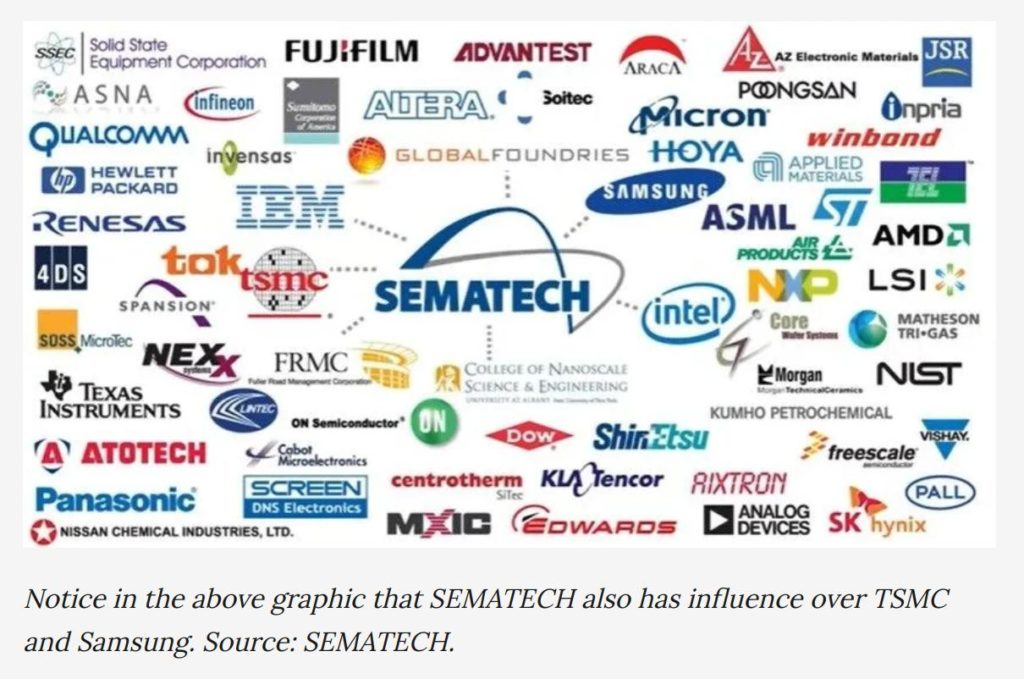
In case the chilling reality of this has not fully sunk in, what the formation of SEMATECH along with the National Cooperative Research Act meant, was that the U.S. Department of Defense was the sole proprietor of R&D research in practically ALL fields of science and engineering. In other words, the U.S. Department of Defense would be the sole conduit at the core deciding where funding goes, which projects should be prioritised and downgraded, and which projects should be killed in their cradle never to be talked about again with threat on your life.
For those who take issue in all advancement of technology because they are fearful that we are heading towards such dystopic visions as Terminator, the Matrix, or Bladerunner, this is not because this is what humans “naturally” do, it is not even fair nor accurate to say that this is what all countries will inevitably do. It is namely what a country will do if the military industrial complex is its sole reason for existing on this Earth. And it will feed this monster at the cost of the welfare and livelihood of its actual people, as we see so clearly occurring specifically within the United States.
And yes, this is specifically striking in the United States, especially since the 2007-2008 financial crisis, to which the U.S. has yet to do anything differently in terms of how it runs its finances, despite countless Americans losing their homes and more while the big banks have been repeatedly bailed out with taxpayer money.
Today, the U.S. continues to spend hundreds of billions of dollars on its military industrial complex and leaves the ever-growing poverty, suicide and drug abuse unaddressed while it loudly blares its woke priorities as to how to speak in such a way that no person could possibly be emotionally offended and in the process render anything you have to say entirely irrelevant.
People should wake up and realise that they are not mad because of this or that label, it is because your future was stolen from you, and it was done by the hand of your very own government.
Your oppression in situated in your lack of opportunity, in your lack of real choice for a better future. In today’s western world you are free to choose whatever avatar you like but you are not free to make any changes to the status quo that is governed by the military industrial complex, which keeps the American people in ever-increasing poverty and destroys entire nations. What sort of freedom is that?
This is the reason why no decent scientist can hope to accomplish great benefits for their society with any research they conduct in the United States. It is all about business at the end of the day, and there is no bigger business than the military business in the United States, except perhaps “biological research” which is drawing a close second, and technically speaking figures into the military business…
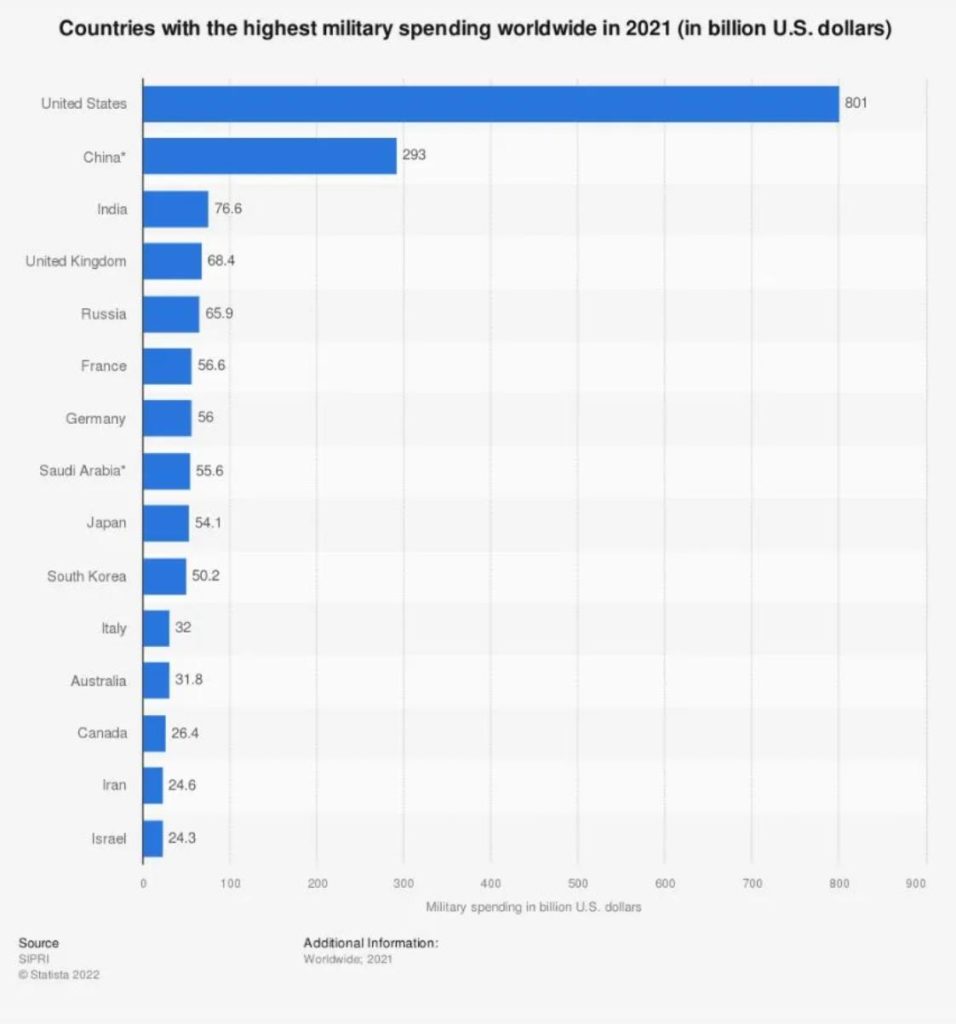
.
Note that in the case of China in the above graph, this is an estimate.
In the case of China what we see is the very opposite to what is occurring in the United States. As the World Bank and BBC attest, surprise surprise, China is doing what they say they are doing in addressing poverty levels, you can read about it on the BBC news site. According to the World Bank, which draws a higher poverty line for upper-middle income countries, to reflect the economic conditions, China is now considered an upper-middle-income country according to the World Bank.
Therefore, China is able to not only compete with the American arms race (in self-defence to the clear war escalation), but it is also able to compete in other areas of more useful endeavours as well as raising its own people out of poverty.
China is not subservient to a military industrial complex and using the lazy logic that if it happened to the U.S. it will happen to China, is to not only disregard what is actually going on in China today but it is also to disregard the cultural orientation of its country and its people.
Now back to our story.
Intel, which would exit out of DRAM in 1985 would turn their focus on logic chips, which they are now a world leader in.
In 1991, the Japanese real estate bubble burst. The real estate bubble had inflated due to the Yen’s appreciation, triggered by the 1985 Plaza Accord.
In 1983 Samsung received a technology transfer from Micron (the company that launched the complaint suit against Japan that started this whole thing off) for 64K DRAM.
To the credit of Samsung, they utilised this technology transfer to maximum use and along with LG and Hyundai were able to produce the 4M DRAM, with their product hitting the market just 6 months after the Japanese.
Micron was one of the few American DRAM producers to have survived the 80s and had made adjustments making production very cheap for their lower-end DRAM chips.
While Samsung was beginning to compete for the lead in cutting edge DRAM technology with the Japanese, Micron in a pincer move flooded the Japanese markets with half-a-generation behind DRAM chips at a cost of $4 when Japan was selling them at $6.
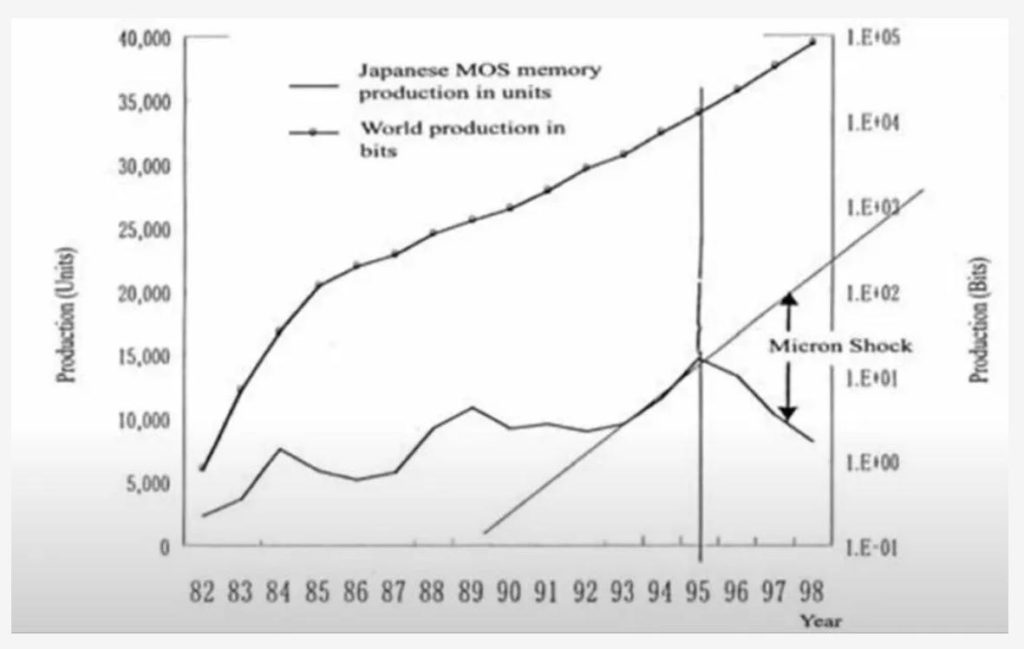
Japan’s semiconductor market was hit from the top by Samsung with their high-end products and at the bottom by Micron with their low-end products, known as the Micron Shock. The Micron Shock set into motion the fall of the Japanese semiconductor manufacturing industry.
128M DRAM prices collapsed by 50% in a single year. Fujitsu exited the DRAM market in 1998. Japanese companies Hitachi and NEC merged their operations together to create Elpida in 1999. They later took over Mitsubishi’s DRAM division in 2002. Elpida was later acquired by none other than….Micron Technology.
Japan’s semiconductor industry is still strong but they are much smaller players in the world market and no longer have a capability of developing cutting edge semiconductors. Companies such as TSMC, Samsung, SMIC, and Intel are much further in the lead. (for more on this story to which I largely drew from refer to Asianometry).
Today, the United States has reopened its arms to Japan in what is promised to be a loving embrace this time around, Japan will open an R&D center for next-generation 2nm chips by year-end under a partnership with the U.S., part of their efforts to establish secure chip supply chains amid tensions around industry leader Taiwan.
Perhaps Japan truly believes it will really be different this time around.
Best Homemade Giardiniera (Hot or Mild)
Not just for hot dogs and muffuletta sandwiches, add this giardinera to your burgers, nachos, pizzas, pasta salads and anything else your heart desires! This homemade giardiniera recipe is simply the best and once you’ve tried it you’ll be HOOKED for life!

How To Make Giardiniera
Giardiniera, pronounced “jar-din-air-ah”, is one condiment you don’t want to be without. And once you’ve tried it you’ll understand why.
Originating in Italy, these pickled vegetables were introduced to Chicago in the late 19th century by Italian immigrants and took their place as arguably the city’s most popular condiment. It’s used on practically everything! You name it, giardiniera is just what you need to bring your hot dogs, burgers, sandwiches, nachos, antipasto platters and pasta salads to life. In Chicago you’ll even commonly find it served on pizzas and, of course, no Italian beef sandwich is complete without it.
Have you been to New Orleans? Giardiniera is the magical ingredient in those mouthwatering muffuletta sandwiches.
In short, giardiniera is the ultimate pickled vegetable relish!

The popularity of giardiniera has continued to explode in Chicago with more than a million pounds of it being sold annually. Still it remains relatively unknown outside of the Windy City except among those with strong Italian roots.
So if you’ve never heard of or tried it before, now is your chance to make some absolutely delectable homemade giardiniera that will bring new life and flavor to your favorite foods!
I’m also including recipes for canning giardiniera so you can store it long-term to enjoy all year round.
You can chop the veggies however large or small you prefer. In Italy the vegetables are usually left in fairly large pieces and that way it’s also more versatile. Left in larger pieces you have the flexibility of serving the giardiniera with your charctuerie/antipasto platters and when you want to use it for sandwiches, hot dogs, pasta salads, etc, you can simply diced up the finished giardiniera into smaller chunks.
But left large or diced small, you are simply going to LOVE this giardiniera!

Let’s get started!
Chop up the veggies and place them in a large non-reactive pot or bowl.
If you’re wondering how to get the crinkle-cut carrots, use a mandolin slicer that has that ability.

Pour 1/4 cup kosher salt over the vegetables.

Pour enough water over the vegetables to cover them.
Let them soak in the salt water for at least 6 hours or overnight. This step is critical for drawing out excess water from the vegetables which would otherwise dilute the vinegar brine and lead to spoilage.

To prepare the jars, place the spices into each of the jars.
I like to make some batches hot and some mild. Do that by using or omitting red chili flakes. For a true Chicago-style giardiniera you’ll want to make it hot.

Thoroughly rinse and drain the vegetables before dividing them up between the jars. Pack the vegetables in as tightly as you can.
Place the garlic each jar.

Now we’re making a vinegar solution to pickle the vegetables.
To play it safe Cooperative Extension Service sources recommend a 1:1 ratio of vinegar to water. Some other recipes may have a lighter vinegar brine but if you’re planning on storing your giardiniera for more than 2 weeks, we recommend this ratio to create enough acidity to prevent the risk of unwanted bacteria.
Bring the water, vinegar and salt to a boil.

Pour the boiling brine over the vegetables leaving a little more than 1/2 inch headspace from the top.

Pour the olive oil over the top.
Wipe the rims with a wet paper towel and seal the jars.
If you plan on using the giardiniera within two weeks let the jars sit at room temperature for a day or two and then transfer them to the fridge.

If you’re canning the giardiniera for long-term storage, seal the jars with the lids and rims and prepare a boiling water bath. Boil the jars for 10 minutes. Carefully remove the jars and let them sit undisturbed for 24 hours before moving them.
Adjustments for high altitudes:
- At 1,001 to 6,000 feet (305 to 1,829 meters) above sea level: increase processing time by 5 minutes.
- Above 6,000 feet (1,829 meters) above sea level: increase processing time by 10 minutes.
If processed in the water bath, the giardiniera is best consumed within 6 months but will keep for at least a year.
**NOTE: If you’re canning the jars for long-term storage it is critical to be sure you thoroughly wipe the rims of the jars to ensure no oil residue is on them, otherwise they will not seal properly. Alternatively, you can omit the oil during canning and add it later to your giardiniera when you open the jar.

Ingredients
- 1/2 head cauliflower, chopped into small florets
- 10 ribs celery , diced
- 5 carrots , diced
- 2 large red bell peppers , seeded and chopped
- 1 cup sliced green pitted olives
- 4 serrano peppers (or more according to heat preference) , sliced
- Spices/Ingredients for EACH pint jar:
- 1/2 teaspoon dried oregano
- 1/2 teaspoon coriander seeds
- 1/4 teaspoon yellow mustard seeds
- 1/4 teaspoon fennel seeds
- 1/4 teaspoon black peppercorns
- 1/4 teaspoon red chili flakes (optional, for hot giardiniera)
- 1/8 teaspoon celery seeds
- 1 bay leaf
- 1 clove garlic, cut in half
- 1 tablespoon extra virgin olive oil
- For the Brine:
- 4 cups white wine vinegar
- 4 cups water
- 2 tablespoons kosher salt
Instructions
-
Place the chopped veggies a large non-reactive pot or bowl. Pour 1/4 cup kosher salt over the vegetables and enough water to cover them. Let the vegetables soak in the salt water for at least 6 hours or overnight.
-
To prepare the jars, place the spices into each of the jars, reserving the garlic and olive oil until after the brine is added. (I like to make some jars hot and some mild by adding/omitting the red chili flakes).
-
Thoroughly rinse and drain the vegetables before dividing them up between the jars. Pack the vegetables in as tightly as you can. Place a clove of garlic (cut in half) in each jar.
-
To make the brine: Bring the water, vinegar and salt to a boil. Pour the boiling brine over the vegetables leaving a little more than 1/2 inch headspace from the top. Pour a tablespoon of olive oil over the top in each jar. Thoroughly wipe the rims with a wet paper towel, ensuring no oil or other residue is on them, and seal the jars.
-
If you plan on using the giardiniera within two weeks let the jars sit at room temperature for a day or two and then transfer them to the fridge. The flavor only gets better with time so wait at least 2-3 days before eating it. Will keep refrigerated for 2 weeks.
-
If you’re canning the giardiniera for long-term storage, seal the jars with the lids and rims and prepare a boiling water bath. Boil the jars for 10 minutes. Carefully remove the jars and let them sit undisturbed for 24 hours before moving them.
If processed in the water bath, the giardiniera is best consumed within 6 months but will keep for at least a year.
**IMPORTANT NOTE: If you’re canning the jars for long-term storage it is critical to be sure you thoroughly wipe the rims of the jars to ensure no oil residue is on them, otherwise they will not seal properly. Alternatively, you can omit the oil during canning and add it later to your giardiniera when you open the jar.
Common Prosperity
For the last year, all I have heard from China pundits is that its property market will eventually be saved. They have been non-stop wrong. China’s property market has not bottomed. Authorities have been slow to react and did little when they moved. The overriding ideological shift coming from Beijing – of Common Prosperity and “houses are for living in, not speculation” – is intact. Even Worse, the underlying driver of the policy shift, deteriorating demographics, has only fallen away faster than expected. Some months ago I declared that we are past the tipping point in this market adjustment. By that, I meant it was now self-fulfilling. Expectations and psychology are broken. Neither buyers nor developers have any desire to leverage up into an asset class that is being sat on by Beijing forever more, even if it is fed short-term stimulus.
Reform always come with pain, initial stage of anti corruption also affect the economy, but in the long run, the pain is transitional and worth it. The time will come when: 1) whereone in China with a job will not be homeless 2) Low property and rental cost will ensure affordability across the nation 3) with such attractive factors of doing business across China, the country will stay super competitive in retaining and attracting manufacturing and business investments both domestically and internationally 4) when cost of living stress is under control, families will have the ability to have more children 5) instead of spending most of the money on rent and mortgage repayment, the average Chinese population will have extra money to spend on everything else, the pillar of economy based on consumption will enhance, wealth will be more equally spread across the country with many mum and dad businesses benefited from 1.4b consumers spreading across the country. 6) the crusader capitalists won't allow such thing to happen in their country as they want to suck in all the money from every individuals. Cheers Chua
China will collapse because they care too much about their people!
They should be like America… Feed The Greed!

.
What did it mean to be ‘exiled to Siberia’ in Tsarists Russia?
Imagine you live in 19th century St. Petersburg. You are of noble birth, and you have a swanky townhouse, maybe even a baroque palace. You have a summer estate, where your serfs toil, within a couple of hours’ carriage ride from the capital. You go to all the best parties. You go to the dramatic theater every Tuesday and Thursday, and to the opera on Fridays. You’re friends with all the best people. Life is good.
But one day, you make an improvident joke in public, which gets written down and circulated, and the Tsar’s secret police has decided to exile you to Siberia. What does that mean?
Well, let’s say you’re dispatched to the classic destination of Beryozovo, where Prince Menshikov (and his daughters) died in exile in 1729.

Alexander Menshikov in exile
Beryozovo is located at a distance of almost 2500 km (1550 miles) east-northeast of the capital. Your carriage ride, which you will undergo in the company of a rude guard with halitosis and smelly feet, will take weeks.
Every little comfort, every item you intend to take with you will require official permission. The Tsar’s police will actually go through your luggage, item by item, telling you what you can and can’t take with you. You will probably be allowed to pack just a couple of books, predominantly of a religious nature — a Bible, Lives of Saints, a psalter — that’s about it. You will be allowed to bring a few religious articles you need for worship, some clothes and a few personal items. A roll pillow, maybe? Beyond that, an official permission is unlikely to be forthcoming.
You will set out likely in late summer or early fall, when the mosquitoes have subsided, but the roads are still relatively dry (being dry is a luxury in Siberia, as you will soon learn).
One often overlooked aspect of Siberian exile is the psychological torture, which the Tsarist regime perfected into an art form. Your journey will be lonely. A hundred miles or so east of St. Petersburg, you will be entering the poorest, least developed part of Russia. You will spend your journey in a tiny, unheated carriage, in the company of an absolutely odious person, who will make your life a living hell. That person was likely assigned to accompany you to Siberia as a form of punishment for some transgression, and he will transfer all his anger and resentment onto you. He will pick his nose. He will take off his boots and rewrap his feet in the carriage. He will belch. Weeks, and weeks, and weeks, and weeks of this. No, you will not grow fond of this fellow, nor he of you.
Eventually, the road will come to a crude stone stele, leaning and in danger of falling over, where your guard will invite you to get out. This stele marks the border between Russia proper and Siberia. Prisoners heading to Siberia were routinely invited to stop at that spot and to bow towards Russia and pray. In case you’re confused about this, your guard will explain that there is a good chance this is the last time you’ll lay eyes on Russia, and so you should make your good-byes now.
As you head deeper into Siberia via an endless dirt road…

your carriage will get stuck in the mud with increasing frequency. You will have to get out and walk through unimaginable muck, sometimes hip-high. Sometimes you will have to assist in pushing the carriage. You will get dirty. Within a week, every single item of clothing you possess will be covered in filth. Obviously, there is no laundry en route.
There will be fewer and fewer conveniences along the road. You will stay in awful, dingy, unheated rooms, sleep in broken beds on straw mattresses covered (if you are lucky) with dank and rotten bedding. You will eat hardtack, day-old cabbage soup and mushy buckwheat with grease.
Eventually, you will get to your destination — a town of rough-hewn, half-sunken wooden houses, where the mud in the main thoroughfare comes up slightly below the knee in the summer, and slightly above the knee in the winter. Your dwelling will look something like this:

(Assuming you got the government’s permission for windows — yes, you had to have permission for those.) Except, the windows in your izba won’t have glass in them — they will be covered with calf’s skin, burlap or rags. Window glass is a high-level luxury in Siberia at this time, and you will almost certainly not be allowed to have it. Your izba will have an open hearth, which will fill the place with smoke — in Russian, this is called “black heating”. To have “white” heating, you would need official permission, and to get skilled artisans to come build you a proper petch with all the necessary guts.

Russian petch with “black” heating, meaning smoke billows into the room.
Most likely, though, the government won’t authorize you to get a smokeless heating system, at least not right away. They’ll want you to suffer some, and won’t relent until “black heating” has done a number on your lungs. If you didn’t have consumption before, you’ll probably develop it. If you already had consumption (which was not unusual for the swampy St. Petersburg climate), it will get significantly worse. You’ll have blepharitis.
Even if you still have access to your family’s money, and can bribe your way into having conveniences, even luxuries — hell, Decembrists built their own wooden Siberian Paris, complete with a club — some things are just hardwired into the whole Siberian exile experience. Imagine a most remote, dusty town — only without the Internet, radio, television or most books. Food is seasonal, and awful. You will lose teeth, and you will have to consume deer blood or raw liver to avoid scurvy. The population is mostly soldiers, laborers, peasants and criminals, predominantly illiterate. Fully 50% of them, if not more, have syphilis. Nearly 100% of them are alcoholics. The two most sophisticated town denizens are a hard-drinking “doctor”, who is probably just a barber who calls himself doctor, and an equally hard-drinking priest, who is serving out his own punishment. The “doctor” is the only medic for hundreds of miles. Before every surgery or other procedure, he must imbibe at least 4 ounces of vodka; this is the only way he can stop his hands shaking long enough to perform an amputation. The only other medical professional in town is an illiterate medicine woman – slash – midwife who knows local herbs, mushrooms and berries. She can help you if you have a mild case of the runs, but not if it’s anything more serious than that.
You will be under constant surveillance by an alcoholic gendarme, who will rifle through your things every few days. All your letters will be opened, read and copied before you get them. Your guards will write regular reports to St. Petersburg, so you would be well-advised to be on your very best behavior.
There is really nothing to do. You have to devise your own entertainment — write your memoirs (which will, of course, be scrutinized), play with local children, learn gardening, pray.
The climate is insane. It’s brutally cold in the winter, but in the summer, it’s practically the Guatemalan jungle, with sweltering tropical heat, 100% humidity and merciless swarms of mosquitoes and midges that just devoir you alive, burrow into the corners of your eyes, take up residence in your ears. When this radical changeover occurs in the spring, massive flows of water on those great Siberian rivers push up against giant ice plugs further up north, in the Arctic, leading to stupendous flooding every spring. There is water everywhere, including your living room, followed by impassable oceans of mud (everywhere, including your living room). There isn’t a single minute of your existence when you aren’t uncomfortable — not a moment when you aren’t freezing cold, or sweating in the summer heat, or being swarmed by insects, or having itchy eyes and migraines from the smoke in your izba.
Hopefully, your family back in the capital is advocating for you and bribing court officials as needed. Perhaps you will eventually be allowed to move to a bigger town, or slightly closer to Russia. If you are lucky, in a few years you may be permitted to transfer to your baronial estate and remain there under house arrest. If you are super-lucky — like, if there is an actual regime change — you may be allowed back in the capital.
Unless you die first.
Is the U.S. too far behind to catch up?
Intel was scheduled to have its 7nm chips in production by 2021, instead one year later, Intel has yet to develop the capability of 7nm chip production which they hope to achieve by the end of 2022 or early 2023.
However, despite China having figured this all out in 2021, we are still supposed to believe that China is hopelessly behind the U.S. in the semiconductor race. Back in July 2021, Intel is still making big announcements of their comeback, now moved back to the year 2025…
2025 is something that is almost lightyears away in the semiconductor R&D. Who knows what TSMC, Samsung and SMIC will have achieved by then, there may even be a new form of technology to replace the entire present way of doing things. Perhaps the U.S. is used to making these predictions assuming everyone else will remain stationary? Someone should tell them and their investors that this is no longer 1985.
With this set back in mind that things tend not to run on schedule in the semiconductor business, is it a feasible prospect of the United States to increase its onshore manufacturing capabilities so that it can control much more of the supply chain within its domestic market?
The short answer is no. But don’t take it from me, take it from Morris Chang, an elder statesman of the semiconductor industry who founded and formerly chaired TSMC, who put this smack of reality most bluntly in remarks addressed to the U.S. as reported by NIKKEI Asia:
“If you want to re-establish a complete semiconductor supply chain in the U.S., you will not find it as a possible task,” he said at an industry forum last year. “Even after you spend hundreds of billions of dollars, you will still find the supply chain to be incomplete, and you will find that it will be very high cost, much higher cost than what you currently have.”
Despite these words of advice, amidst what I think can be fairly called an economic recession if not depression, the United States has just recently passed the $52 billion CHIPS Act, with $39 billion planned to be spent domestically, to namely benefit, you guessed it, the military industrial complex.
U.S. Commerce Secretary Gina Raimondo warned in a recent interview with CNBC while the CHIPS Act was being considered by Congress:
“If you allow yourself to think about a scenario where the United States no longer had access to the chips currently being made in Taiwan, it’s a scary scenario…It’s a deep and immediate recession. It’s an inability to protect ourselves by making military equipment. We need to make this in America.”
Notice the only concern she names by name? The military industrial complex. At some point Americans need to ask themselves, what is the point of all of this military equipment if the American people’s livelihood is not economically secure, in violation to the promise of freedom from want as one of the four core American freedoms. How is the American government providing the American people security if they do not even have enough food to eat and have no homes to live in but increasingly ghettofied communities living like an ant colony. Or Elon Musk’s ridiculous house box. They are literally selling boxes for homes as if this is some sort of luxury product.
Why is it ok for Americans to increasingly have no access to the most basic of basic needs while hundreds of billions of dollars are poured into Department of Defense Frankenstein projects?
In case you haven’t noticed, the Cold War has been going on for 76 years now. When has the military industrial complex ever been justified and not in fact based on conscious lies? President Eisenhower departed his office actually acknowledging that he left a monster growing in the basement and had no idea how to get rid of it in his farewell address:
“In the councils of government, we must guard against the acquisition of unwarranted influence, whether sought or unsought, by the military-industrial complex… The potential for the disastrous rise of misplaced power exists, and will persist.”
Honestly, he might as well have gotten into a helicopter and left the country waving like Nixon did while the Americans all stared dumbstruck. But somehow we largely regard that speech as if it were something respectable. Let us call a spade for what it is. And what happened to the next President who was elected to address the matter? His brains were splattered onto the pavement in broad daylight on live television.
Anyway, I digress, back to the matter of American supremacy…
The U.S. is confident that it can once again unleash its jungle roar of supremacy with the help of TSMC. TSMC is scheduled to building fabs (semiconductor fabrication plants) in the U.S. and Japan.
Intel doesn’t expect its new fabs in Ohio to begin production until 2025. Intel is also building two new factories in Arizona expected to go online in 2024. That’s when TSMC and Samsung also plan to open new fabs in Texas and Arizona, respectively. What this means is essentially that they have agreed to share some of their trade secrets with the U.S.
This is likely not being done voluntarily, without some very scary threats.
As NIKKEI Asia reported Taiwan’s government is keenly aware that if TSMC were to move production sites it could weaken the island’s security position, analysts say. For many analysts, those factories and their role in the global economy act as an insurance policy for the island.
“The Taiwanese government will definitely hope TSMC keeps its most cutting-edge factories all in Taiwan,” said Su Tzu-yun, director of the Institute for National Defense Security Research in Taipei. “That could make Taiwan a safer place. No one would want to damage TSMC’s advanced chip production capacities, which are the hearts of many electronic devices…We don’t think the tension and competition between the U.S. and China will end any time soon…As a crucial supplier, TSMC may still face a tough issue later – choosing sides.”
TSMC is thus stuck in a very tight spot right now. What Taipei should also understand is that Taiwan is expendable to the United States, but it is not expendable to China. Rather, Taiwan is actually essential for China’s security. Taiwan needs to realise that words are words but actions are another thing. Independence for Taiwan is not a reality. It is not an economic reality. And it is not a political reality (not to mention cultural reality).
The United States will not stop until Taiwan becomes its own military base (added to the list of South Korea and Japan) and becomes an upholder to U.S. hegemony in the area, which pretty much runs counter to every country’s interest in South-East Asia. Or Taiwan can return to China and receive protection from America’s war mongering. China will do this one way or another, that is, defend their land against a U.S. invasion, but it would be nice if Taiwan had its head together if such a stand-off were to occur.
In case you have not been informed, Taiwan is internationally recognised, including by the United States as part of China. China has enough missiles to defend Taiwan without any issue. For more on China’s military capability refer to ex-Marine Brian Berletic’s New Atlas.
Thus, though Intel has high ambitions to somehow be in the lead in 2025 despite only being thrown scraps from the alley presently, the elephant in the room here is that the U.S. seems to have lost any ability to actually be an innovator in the field. The only thing keeping them in the game right now as a leading cutting edge semiconductor manufacturer is their use of intimidation and threat of force.
The writing is on the wall, as Russia and China gain in economic and military supremacy, South Korea and Taiwan will be free to conduct their business as they choose and not be obligated to constantly give the U.S. favors under uncomfortably tense situations threatening the very sovereignty of these companies let alone countries.
Another rather large factor to the U.S.’ miscalculation in their strive for supremacy is the matter of a little mineral called Fluorite.
Fluoropolymers are a key material for semiconductor production. Fluoropolymers are processed from fluorspar, also known as fluorite, a mineral of which China controls nearly 60% of the global production output, according to data from market research company IndexBox. China has long identified fluorspar as a strategic resource and back in the late 1990s limited exports due to its importance to industries from agriculture, electronics and pharmaceuticals to aviation, space and defense.
In a supply chain review paper published by the White House in 2021, the U.S. flagged the risks of critical materials subject to foreign domination and identified fluorspar as one in a list of “shortfall strategic and critical materials.”

An independent commission established by Congress recently concluded: “If a potential adversary bests the United States in semiconductors over the long term or suddenly cuts off U.S. access to cutting-edge chips entirely, it could gain the upper hand in every domain of warfare.”
The Centre for Strategic and International Studies (CSIS) reports “China’s leaders have set a goal to build a ‘fully modern’ military by 2027 based on ‘informatization,’ ‘intelligentization,’ and ‘mechanization,’ investing heavily in technical areas which support such an approach, such as AI, quantum computing, hypersonics, and microelectronics.”
As the chair and vice chair of the National Security Commission on Artificial Intelligence (NSCAI) put it in 2021, “We do not want to overstate the precariousness of our position, but given that the vast majority of cutting-edge chips are produced at a single plant separated by just 110 miles of water from our principal strategic competitor, we must re-evaluate the meaning of supply chain resilience and security.”
U.S. dependency on Taiwanese production of chips for defense systems extends beyond AI. TSMC makes semiconductors used in F-35 fighters and a wide range of “military-grade” devices used by the U.S. Department of Defense (DOD).
Interestingly, the CSIS report acknowledges that advances in semiconductor technology are primarily driven by the development of devices for commercial use.
Which is what China is exactly focusing on right now. Recall China was the number one world supplier of semiconductors for commercial use with 75% of all semiconductor production coming out of East Asia.
What China has done in fact is, to quote Pascal Coppens, set up an ecosystem in Shenzhen that will allow for top industrial focus on all levels of the semiconductor production line for commercial use, while SMIC, HUAWEI, and HiSilicon focus on the cutting edge semiconductor technology. As Pascal Coppens makes the point, China’s semiconductor ecosystem is in fact a form of decentralization, while the United States is approaching the semiconductor race from an approach of centralization (around the military industrial complex).
TSMC is bottlenecked due to the reasons already discussed above. TSMC is operating at around 60% capacity and to achieve 80% capacity would be considered an incredible achievement. China has the ability to correct the semiconductor shortage that is bankrupting western companies right now, including the automobile industry. And 90% of the chips needed to make the smart world will have to come from China. Recall, TSMC owns 10% of SMIC stocks, if SMIC is able to meet these demands, TSMC stands to benefit greatly, much above what they are capable of producing as output.
And everyone knows, there is no greater romance than a forbidden romance.
- Cynthia Chung is the President of the Rising Tide Foundation and a writer at Strategic Culture Foundation.
- Please kindy consider consider supporting her work by making a donation and subscribing to her substack page.
- This article was originally published by Strategic Culture Foundation.
Button
I have a very odd 4 year old black cat called Button, he was the runt of a litter and I had intended to keep just 1 kitty but in the end only 2 lived so I kept both. He was so tiny for months but he almost caught up.
Anyway that’s not an answer is it.
Odd: he has done several odd things and still does, but 2 of the most clever/amusing things he does are 1) He hates rain, he also has never peed in the house. I was in the kitchen doing something and I saw Button had climbed into the sink, then we heard the trickle and saw the “peeing” stance, I was so shocked and both me and my mate stood mouth agape as he peed and jumped down and back to the sofa. I have had at least 30 cats over my lifetime and I have never witnessed this happen without it being trained (as much as one can train a cat). I so wish I’d had my phone on me but no.
His 2nd display of odd behaviour regards the cat flap.
All my cats use it, its operated by their chips, however when a cat comes IN the flap often doesn’t close properly, maybe an inch open so no biggie to me. Button however sees it as the most heinous crime and promptly walks over to the flap and closes it with one paw, satisfied, he then returns to my side and he does this EVERY timethe flap doesn’t close properly.
Now tell me that aint weird.

Biden’s AMD and NVIDIA chip export ban just the start as White House set to attack China’s IC capability more aggressively
An indulgence in the unrelenting sanctions of the rest of the world. This article is on China. The US is now Shutting oneself out of the world biggest chip market, which happens to be China. Who are the US companies going to sell to now? Zambia, Nigeria, Brazil, France? How are their electronics industries? Instead, this provides the Chinese chip industry with a wide-open opportunity. It can now exclusively enjoy the $300b worth of annual chip import market among themselves and growth bigger and stronger. Thank you Biden.
It looks like the White House is gearing to announce sweeping new processor chip-making tool export ban restrictions, claim insiders privy to the Department of Commerce plans.
After banning NVIDIA and AMD’s latest AI processor shipments to China, now the Commerce Department is set to expand the blacklist to include the actual equipment needed to produce sub-14nm chips…
The world’s first 6S50ME-B electronically controlled marine diesel engine
The world’s first 6S50ME-B electronically controlled marine diesel engine is made in China. The main engine has a bore of 500 mm and a single-cylinder power of 1,660 kW for a total power of 9,960 kW. Due to the adoption of the latest electronic control technology, the entire operation is controlled by a computer, with the best operating parameters, convenient and reliable control, and remote control and 24-hour unattended in the engine room. It meets the latest Nox emission standards from the International Maritime Organization (IMO). 1 horsepower / hour fuel consumption can reach the highest level of 170 grams. Compared with the other main engines of the same power, only in fuel costs, this main engine will save more than 1 million US dollars in fuel costs during the entire life cycle.
Four black clad “pro-democracy” youth try to attack HK police.
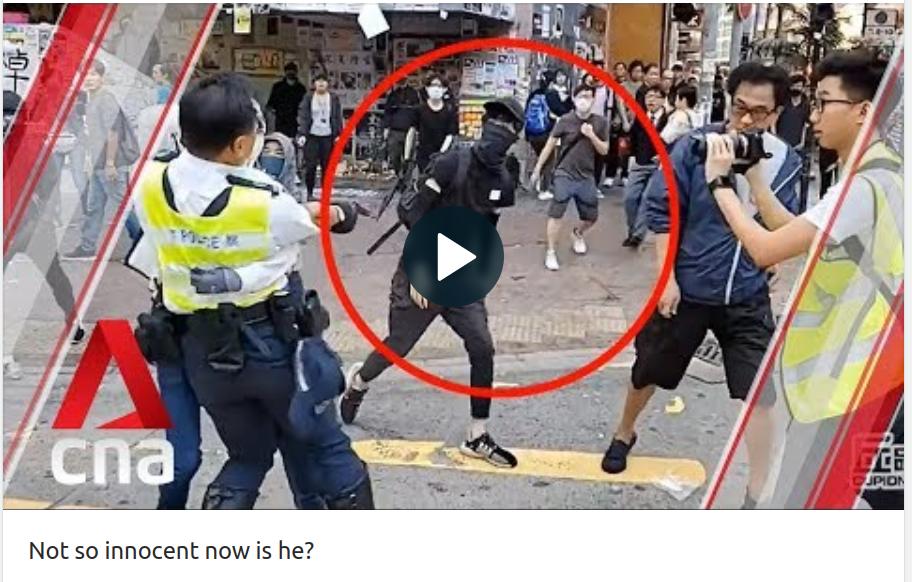
And HK arrest them FIERCELY.
Ans some USA bloggers complain.
Here’s a (portion of) comment tree…

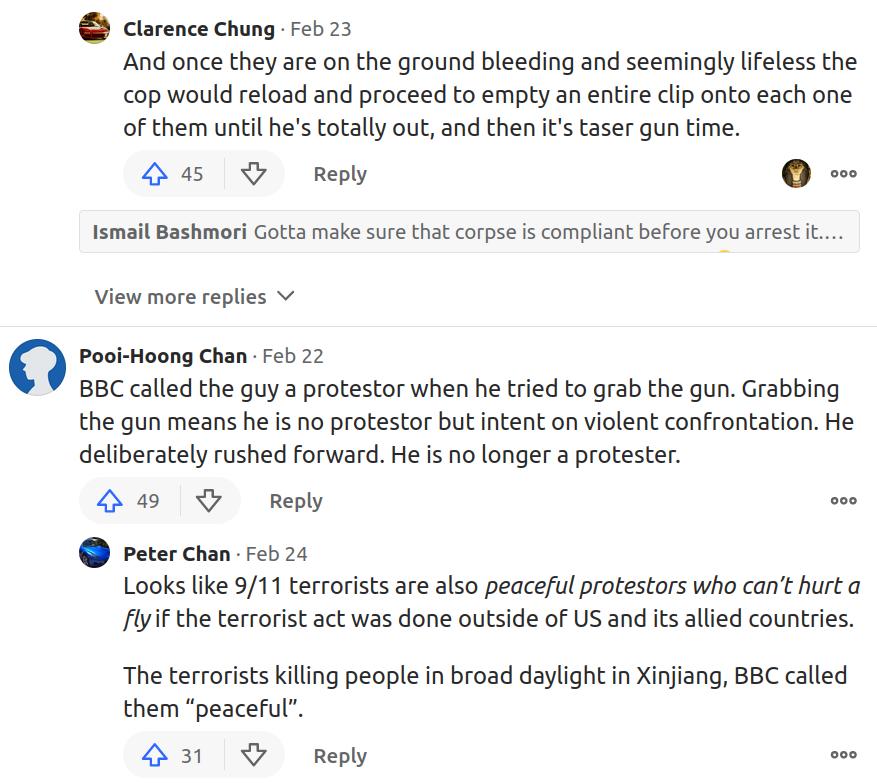
How likely is it that a home flight sim enthusiast with over 10,000 hours on any aircraft type could land the real deal without any assistance?
As a home flight sim enthusiast with thousands of hours in X-Plane and Microsoft Fight Simulator, I decided to give the real thing a try at the beginning of this year, flying a 1976 Cessna Skyhawk M out of a small non-towered field. I sat in the left seat with the right seat occupied by my flight instructor, a former Navy F-18 pilot and airline 737 captain who had eighteen-thousand flight hours of experience. The panel looked like this. Although it was an earlier model Skyhawk versus the newer versions in the sim, everything was immediately recognizable:

A giddiness washed over me as I inspected the real versions of the simulated gauges. When we did the pre-startup checklist, it was the same as I’d done in the sim and I could almost execute it from memory. I was fairly certain I could have started the aircraft on my own with no instruction. The familiarity swelled my confidence. I’ve got this.
The first nibble at my confidence occurred shortly after I set my feet on the rudder pedals and started to taxi. Although I’d used rudder pedals in the sim before, the real pedals not only had resistance but also lag. They were physically linked to the Skyhawk’s nose wheel and, like a shopping cart’s wheels, when the wheel direction was not in line with the plane’s direction you needed to nudge it back to where you wanted. Taxiways have a yellow centerline for the nose wheel. Despite my best attempts, I painted a drunken s-shaped curve back-and-forth around that centerline. At one point, my instructor needed to take the controls to reset us.
Rolling out on the runway and taking off was very easy. As the ground fell away and the blue sky filled the cockpit windows, my left hand on the yoke and right on the throttle, a childish grin dominated my face. I am flying. I am really doing it.
Flying itself isn’t inherently difficult. The Skyhawk has stability designed into it and most of the time if you take your hands off the controls and literally do nothing it will tend to sort itself out. I found turns felt very much like the sim and in no time we were zipping around the practice area doing basic maneuvers. My confidence meter slowly ticked back up. When the instructor said, “Do you want to do some more maneuvers or head back to the field and try some landings?” I grinned. This is it! This is what I’ve practiced for. “Oh,” I chimed, “head back to the field and try some landings.”
So, here we were flying in the downwind with the field halfway up the left strut – just like in the sim – coming abeam the numbers, throttle reducing, my right hand pushing down a notch of flaps, the instructor’s voice guiding an endless stream of speed and control nudges, the horizon rotating right as the plane rolled left into the base leg. As I rolled out, the field stabilized over my left shoulder, the white runway numbers beckoning. Yes! We were going to do it. I was going to do it.
What I would learn much later on, after dozens of landings, is that things happen very quickly during the final phases of landing, and the difference between being able to land versus doing a go-around may be a second of inattention or an inch too much of back pressure during the flare. During the downwind to base turn, for example, simply letting your nose dip too much for a second or two can add ten knots to your speed which starts a cascade of corrections. Now, toss in the fact that the air is doing something unique every time you land and it’s a lot of variables. Variables which, despite how high-end the sim is, just aren’t modeled.
“Ground. Ground is coming up,” I’d said as the green patch of grass ascended alarmingly quickly towards the cockpit windows. “My controls,” the instructor said, bailing us out. I had gotten us within about fifty feet of the runway, but we were a non-stabilized mess that needed someone who knew how to react to all those changing variables, and that was not me. I admit, I was bummed. I’d built up that I was going to ace it, but reality was more complex. It’s not just the level of sim, either. Once I started taking flight lessons, I flew in the school’s Redbird simulator (which we used for simulated instrument flight) and it felt nothing like the real plane. In fact, I could land it fairly easily although I was still struggling with real-life landings.
I’d say it took me about ninety real-life landings before I was consistently landing well. Sure, I could land within the first few lessons, but there’s quite a difference between the controlled collision with the runway that comprised those early landings and what I’d be doing after much practice. So much of flying is by touch and landing in particular relies on your sight picture and feeling the plane’s energy state. I think as an engineer I found my difficulties particularly frustrating, because in my mind it should all be some equation to solve.
There’s a commercial pilot in my flight school who told me, “Landing will be a struggle, but one day you’ll wake up, you’ll do all the same things you did yesterday, but today you’ll just know how to land. After that, all your landings will be good.” Although I doubted him, after lessons of struggling, I came back on a Saturday morning and just started setting landing after landing down gently on the runway. “I don’t understand,” I’d said to my instructor, “I didn’t do anything different.” He smiled. “Don’t think about it. Just keep doing it.” And I did keep doing it. I still don’t know what changed that Saturday – maybe I finally trusted my sight picture or maybe I relaxed and trusted my training and intuition – whatever it was, it wasn’t something I found in the simulator.
The other thing I’d say is that the way I was landing in the simulator was different than the way I’d learn to land in real life. In the sim, I’d flare to arrest my descent rate, then ease the controls forward to set the plane down. The first time I did that in real life earned me an admonishment from my instructor. I recall seeing his entire posture stiffen in my peripheral vision as his hands reached for the controls. I realized that was bad.
Simming really helped – don’t get me wrong. Every now and then I stumble upon a pocket of expertise I’d gained from simming and that part of the lesson moves to easy mode. For things that rely upon feeling the plane, though, the only way for me to do that was to sit in the real plane and try it again and again until it clicked. I don’t doubt there’s someone with a ton of sim experience who could probably get it right on the first time, but for me I couldn’t even do it on my first try with an F-18 pilot sitting beside me and walking me through it.
The United States has built “Asian NATO” in Asia against China in the South China Sea, which is supported by America, Australia, Japan, South Korea, and India. Isn’t Taiwan the Ukraine created by America?
Don’t include India in that. I doubt Japan and South Korea will want to fight China either. This is all hot air. Taiwan is being used by the US as a bait to provoke China. The Taiwanese who support US involvement, well the political elite, are in turn using the US for financial gain too. Its all a big game.
Good hearted people will hope that peace can prevail and no war occurs. Negotiation is important. Who wants another Ukraine?
If you want a war in Taiwan; enlist now and volunteer so you can fight in the front line. Otherwise if you are an evil coward who wants to witness war from behind your TV and computer screen thousands of miles away in the US, you can go to hell.
Kate talks about China
Four months in, and living in China is not at all what I expected. As an American who does not speak Chinese, I expected more struggle and confusion, more culture shock, more…difference.
My husband and I are in Nanning, in the southeast–just 100 miles from the Vietnam border. Yes, there’s an active vibe here–but also a laid-back one. I was surprised to discover that siesta isn’t just for Spanish-speaking countries; it’s a thing here, too. From noon to 2 p.m.-ish, the campus where I teaches virtually closes down as do many businesses. I’m beginning to get into the afternoon peace and quiet. I even nap now and then, not my usual forte.
Yes, of course, there are big differences between China and America. But they aren’t hard to handle so far. The language, for example. I have not had the time (okay, discipline) to focus on learning it the way I’d like. Still, my husband and I can jump in a cab and say the right phrase to get us home. Translator phone apps help. And we are learning tricks, like collecting business cards, taking pictures of the fronts of buildings, or having someone write down our destination in Chinese. Just show the card or picture to the cabbie, and you’re off. And there’s always body language and contextual charades!
People enjoy interacting with us. They love to stop and ask us questions (Where are you from? Do you like China?) and take pictures. Yes, sometimes all the attention is a bit unnerving. Like when strangers crowd around you, wrap their arms around your waist and take a selfie. And another and another…until you have to smile and say xie xie (thank you) and sidle away.
Sometimes I’m just standing somewhere talking with a friend, and out of the corner of my eye I see several people snapping our pictures. It’s only fair, though. I often take pictures of charming strangers. No double-standards here.
I thought this attention was all about my whiteness…until I met an African American guy who has lived in China for 5 years and said it constantly happens to him, too. In a city of 8 million people where 7,999,900 have straight black hair and are of a smallish stature, a tall blonde or an even taller black guy with a bright white smile is a total trip.
Living on campus is great. With its food courts and canteens, two farmers’ markets, sports fields, basketball and tennis courts, many apartments and dorms, it’s like a city within a city. Everyone who works for the university–students, faculty, and staff–lives here, including retired employees. There are people of all ages around, including elderly and children. And on campus are schools (from preschool through middle school) for the kids.
The Chinese love exercise. On my way to class in the mornings (a five-minute walk), I see retired people playing volleyball and badminton. There are big sports fields here where people play on the equipment, kick balls around, practice Kung Fu, walk, jog, stretch.
In the evenings, groups of (mostly women) gather to “square dance”–which is more like line dancing to a boom box that’s blasting anything like traditional Chinese music or pop songs.
People ride bikes and motorbikes everywhere, which adds to the feeling that China = movement. All motorbikes here, by law, are electric. This has the pleasant effect of keeping down air and noise pollution. Some days are hazy here, but for the most part, it’s pretty clean and green.
Even though they exercise a lot, how most of the Chinese people are so slender is a mystery to me, given the abundance of great, inexpensive food–especially noodles and dumplings. I also love all the readily available fresh fruits and veggies at open-air markets. The passion fruit, purple dragon fruit, and small creamy bananas are to die for.
We have not yet bought meat or fish at the open air markets. Perhaps our western sensibilities just aren’t ready to pick from the mountainous slabs of raw meat, or to face a woman pulling a fish from a bucket of water and clubbing it to death for our dinner. Usually we get already-cooked chicken and duck at the fantastic deli in the grocery story.
Early on, we were invited to a mid-Autumn festival meal, where everyone participated in making pork dumplings. All the food was delicious–except the snake, which according to Dave was too spicy. I couldn’t get past the fact that it still had the skin on. More suitable for boots than appetizers, if you ask me.
Okay, snake is one of my exceptions to my proclamation of “delicious food.” Other exceptions include duck and chicken feet (you see them everywhere) and insects-on-a-stick.
In contrast to what people had “warned” me about–that Chinese students are not creative–the students are writing inspired poetry, creating extraordinary video poetry interpretations, and taking lots of creative leaps. In my literature class, they love to perform scenes from the book.
For the most part, the students are eager, kind, and thoughtful. “Class discussion” isn’t what I’m used to; they don’t like to talk unless called upon. However, when I structure discussion and activities using my bag of tricks (such as letting them write or talk out ideas with a partner before talking to the whole class), they get into it. They also love games and role playing.
The only thing I don’t think I will get used to is calling students by their chosen English name–when they are Hamburger, Watermelon and Xylitol. (I’ve learned that many Chinese people who speak some English prefer to use an English name so that non-Chinese speakers won’t mispronounce their real name.)
It’s the connections with people that have been the most rewarding. I believe that if more people traveled (with a warm, open mind) there would be no more war–because we would KNOW we are killing people who are valuable, individual souls with loving families who, just like us, want lives of peace and happiness.
We’ve gotten really close to Tina, our student assistant. When Tina’s bike disappeared, we knew this was an opportunity to buy a useful and meaningful birthday present for this young woman who has done so much for us. At first she refused, saying it was too expensive. But I pulled out all the stops, telling her the dollar was strong, it wasn’t expensive for us, and we would be extremely sad if she said no.
To get to what everyone calls Stolen Bike Street, Tina perched sidesaddle on the back of my husband’s bike. I mentioned she looked so at ease on the book rack, even as we swerved in the traffic madness and hopped over speed bumps. That’s when she told me that when she was young, her family was poor. They had no car, just a bike. Her mother did not like leaving her and her brother, who was an infant, at home. So she would put the baby in the basket, and Tina sat on the back of her mom’s bike. (She added that her parents eventually started a profitable business and now have a car.)
After the purchase of the bike and the eating of lunch, Tina told us she had something she wanted to say, launching into what seemed to be a prepared speech about how much we mean to her. She had barely begun when tears started streaming down my face. She thanked us for being so friendly, for never losing patience when she’s trying to figure out something. She recounted the fun experiences we’ve had, and said, “You have taught me thing about life.” And she was especially touched when one day I told someone she was like our Chinese daughter. She really is. Truly, I love her with all my heart and am amazed China has given us the gift of her.
I can understand dogs’ need to be around humans them but that clearly isn’t so with cats…
Where did anyone say cats “clearly” don’t need to be around humans? Domestic cats have as much need for a human as a dog does. Plus, if the shelters did happen to have enough room for the cats, but no one adopted them, they wouldn’t have room for very long. Cats need space, and not the tiny cages that shelters have to keep them in.
This is Loki:

I adopted him today, just a few hours ago. That was him, at the shelter, crying and scratching at the glass door. He had a pretty big enclosure too. But he stood there crying, just because I was taking a picture of him instead of petting him right away.
This is him when we got home:

He cries if we stop petting him for too long and pretty much just wants cuddles and naps.

Just because cats are (typically) more independent than dogs, doesn’t mean they need human companionship any less. And they’re just as worthy of a home too.
Samarkand Declaration of the Council of Heads of State of the Shanghai Cooperation Organization
Meaty article. Very good. Summary of what came out of the SEO meeting. This is what is going on outside of the western propaganda bubble. Big news. Great stuff. Totally unreported. -MM
1) member states seeking similarities but allow differences 求同存异 2) together we make a lot of money. 赚大钱 3) Worth your time to read in full to understand the civilised nations universal values of inclusiveness, real democracy, mutual respect, mutual prosperity, and working towards a new world order of win-win, peace and harmony. 4) comparing the SCO declaration with the Western "me-only" International rule based order, one will easily understand the meaning of an "inferior civilization."
Translation:
Samarkand Declaration of the Council of Heads of State of the Shanghai Cooperation Organization 2022-09-17 09:44 The leaders of the member states of the Shanghai Cooperation Organization (hereinafter referred to as the "SCO" or "the Organization") held a meeting of the Council of Heads of State in Samarkand on September 16, 2022, and issued the following declaration: ... The world today is undergoing global changes, entering a new era of rapid development and great change. The trend of world multi-polarization is intensifying, countries are increasingly interdependent, and the process of informatization and digitization is accelerating. At the same time, the current international challenges and threats are more complex, the international situation is gradually deteriorating, and regional conflicts and crises are emerging one after another and continuing to escalate. The widening technological and digital divide, continued volatility in global financial markets, shrinking global investment, unstable supply chains, rising protectionist measures and increasing other barriers to international trade have all contributed to the instability and uncertainty of the world economy. Global climate change and the ongoing spread of the COVID-19 pandemic pose new challenges to economic growth, social well-being, food security and the implementation of the United Nations 2030 Agenda for Sustainable Development. To this end, new approaches are urgently needed to promote more just and effective international cooperation and achieve sustainable economic development. Member states hold similar or identical positions on current international and regional issues, and reiterate their adherence to the generally recognized principles of international law, multilateralism, equality, commonality, comprehensiveness, cooperation, sustainable security, and diversity of cultures and civilizations. Under the coordination role of the United Nations Center Through equal and mutually beneficial cooperation among countries, we will build a more representative, democratic and just multi-polar world order. Based on the principles of the SCO Charter, member states oppose the solution of international and regional issues through collective, ideological and confrontational thinking, and insist on coordinating responses to security threats and challenges in traditional and non-traditional fields. Taking into account the opinions of the SCO member states, all parties reiterated that it is of great practical significance to jointly promote the building of a new type of international relations featuring mutual respect, fairness and justice, and win-win cooperation and a community with a shared future for mankind. The member states advocate the right to respect the political, economic and social development path chosen by the people of all countries, and stress that the principles of mutual respect for sovereignty, independence, territorial integrity, equality and mutual benefit, non-interference in internal affairs, and non-use or threat of use of force are the principles of sustainable development of international relations. The basics. All parties reiterated that differences and disputes between countries should be resolved peacefully through dialogue and consultation. The member states reiterate that the SCO will not target other countries and international organizations, and will, based on mutual interests, proceed from a common position to resolve regional and global issues, and in accordance with the purposes and principles of the Charter of the United Nations and the Charter of the SCO, as well as the norms of international law, Extensive cooperation with other countries and international organizations. At present, the SCO, as an authoritative and influential multilateral organization, is committed to maintaining peace, security and stability, jointly responding to new threats and challenges faced by the region, and deepening economic, trade and people-to-people and cultural relations among SCO countries. The member states stressed that the SCO Charter adopted 20 years ago is of historic significance, and it provides the basis for the member states to carry out close and fruitful cooperation on the basis of the "Shanghai Spirit" of mutual trust, mutual benefit, equality, consultation, respect for diverse civilizations and seeking common development. All-round cooperation has laid the foundation. Member states believe that adhering to the above principles will help build a new model of regional cooperation and play a constructive role in consolidating multilateral and mutually beneficial relations in the Eurasian region. The member states are willing to further strengthen policy communication, security cooperation, unimpeded trade, financial integration, and people-to-people bonds, so as to jointly build a peaceful, secure, prosperous and clean world and realize the harmonious coexistence of man and nature. The member states stressed the significance of the 15th anniversary of the signing of the Treaty on Long-term Good-Neighborliness, Friendship and Cooperation among the SCO Member States, and the leaders of the member states approved the "Outline for the Implementation of the Treaty on the Long-term Good-Neighborliness, Friendship and Cooperation of the SCO Member States (2023-2027)" . The member states will continue to strengthen the SCO's efforts in maintaining peace and security, and advocate the peaceful settlement of international and regional conflicts through political and diplomatic means, so as to deepen the relations among the member states and pass on the friendship of the people of the member states from generation to generation The member states believe that Central Asia is the "core area" of the SCO, and support the efforts made by countries in the region to ensure peace and prosperity, achieve sustainable development, and establish a space for good-neighborliness, friendship and mutual trust. All parties support the further role of the SCO in maintaining stability in the region and promoting economic and social development, and welcome the regular meetings of the Central Asian heads of state. Member States noted the successful holding of the Central Asian Leaders' Meeting in Chopon Ata, Kyrgyz Republic, on 21 July 2022. The member states believe that strengthening the connectivity between Central Asia and South Asia will help to achieve the common goal of ensuring prosperity and security in the SCO region through the establishment of sustainable economic, trade, transportation and communication links, and the promotion of dialogue among different civilizations. Member States express their deep concern over security threats arising from any form of terrorism, separatism and extremism, strongly condemn acts of terrorism taking place around the world, and stress the continued implementation of the "Dutch" signed in Dushanbe on September 17, 2021. The importance of the SCO Member States' 2022-2024 Framework for Cooperation in Combating Terrorism, Separatism and Extremism. The member states reiterated that they will resolutely combat terrorism, separatism and extremism, and continue to take active measures to eradicate the breeding ground for terrorism, cut off terrorist financing channels, combat the recruitment and cross-border movement of terrorists, and curb extremism and youth radicalization. and terrorist ideology to eradicate lurking terrorists and their hiding places. The member states pointed out that it is not allowed to interfere in the internal affairs of other countries under the pretext of combating terrorism and extremism, and firmly opposes the use of terrorist, extremist and radical organizations for personal gain. Member States believe that it is important for the international community to work together to prevent attempts to recruit young people for terrorist, separatist and extremist activities, and attach great importance to combating the spread of religious intolerance, violent nationalism, racial discrimination, xenophobia, fascism and chauvinism. The member states noted the effective work of the SCO regional anti-terrorist bodies in promoting cooperation among the competent authorities of member states in the fight against terrorism, separatism and extremism, stressing that joint measures are taken to enhance the potential for practical cooperation in these areas. important. Member States will, in accordance with their national laws, work to develop common principles and positions on the basis of consensus on a unified list of terrorist, separatist and extremist organizations that are prohibited from operating in their territories. The member states noted the results of the "Pabi-Counter-Terrorism-2021" joint counter-terrorism exercise by the competent authorities of the SCO member states and the joint frontier operations "Unity and Cooperation 2019-2021" by the competent authorities of the SCO member states' border agencies, as well as the results of India's 2021-2022 Effective work carried out during the Chairmanship of the Council of the SCO Regional Anti-Terrorism Institutions in 2018. The member states believe that it is necessary to implement the resolution of the Council of Heads of State of the SCO Member States "On Improving the Mechanisms of SCO Member States to Address Security Threats and Challenges" and to study the following recommendations: as a separate permanent body, in Duchamp. Do not establish the SCO Anti-Drug Center (Republic of Tajikistan); Upgrade the SCO Regional Anti-Terrorist Agency in Tashkent to the SCO Comprehensive Center for Security Threats and Challenges (Russian Federation); Establish on the basis of the SCO Regional Anti-Terrorist Agency SCO Information Security Center (Republic of Kazakhstan); On the basis of the SCO Regional Anti-Terrorism Agency, the SCO Center for Combating Transnational Organised Crime (Kyrgyz Republic) was established in Bishkek. The SCO member states will be based on the Intergovernmental Agreement on Safeguarding International Information Security among SCO Member States, signed during the Yekaterinburg Summit in June 2009, and in accordance with the SCO Member States' Cooperation Plan for Safeguarding International Information Security for 2022-2023. ” and other WIPO documents, and continue to cooperate in safeguarding international information security. Member States will strengthen cooperation among national authorities in the field of digital literacy to bridge the digital divide. The member states emphasized the key role of the United Nations in addressing threats to the information space, and advocated the establishment of a safe, fair and open information space on the basis of respect for sovereignty and non-interference in the internal affairs of other countries. Member States believe that it is important to ensure that countries have equal rights in governing the Internet and have cyber sovereignty. Member States firmly oppose the militarization of information and communication technologies, support the formulation of universal rules, principles and norms for responsible state behavior in this field, and welcome the launch of a comprehensive international convention on combating the use of information and communication technologies for criminal purposes under the auspices of the United Nations . The parties will continue to cooperate within the framework of the relevant negotiating mechanisms of the United Nations and other international platforms. Member States call on the international community to play the central role of the United Nations, fully implement the relevant resolutions of the United Nations Security Council and the United Nations Global Counter-Terrorism Strategy in accordance with the United Nations Charter and the principles of international law, strengthen global counter-terrorism cooperation, abandon politicization and double standards, and respect the sovereignty and independence of all countries. , and adopted the United Nations Comprehensive Counter-Terrorism Convention on the basis of consensus. Member States take note of the outcome of the International Conference on the 10th Anniversary of the Joint Action Plan for the Implementation of the United Nations Global Counter-Terrorism Strategy by Central Asian States, held in Tashkent on 3-4 March 2022. Member States take note of the high-level international conference held by the Republic of Tajikistan (Dushanbe Process), the co-organization with the United Nations in Dushanbe from 18 to 19 October 2022 on the "International and Regional Cooperation on Combating Terrorism and Preventing the Movement of Terrorists" Security and Border Control Cooperation” high-level meeting to promote multilateral cooperation to combat terrorism and terrorist financing in Central Asia. Member States noted that the Republic of India, the Islamic Republic of Pakistan, the Kyrgyz Republic, the Republic of Kazakhstan and the Republic of Tajikistan are running for the UN Security Council for the 2028-2029, 2025-2026, 2027-2028, 2039-2040 and 2028-2029 respectively The non-permanent members of the Council, the Kyrgyz Republic and the People's Republic of China are running for members of the UN Human Rights Council in 2023-2025 and 2024-2026 respectively, the Republic of Kazakhstan is running for the presidency of the UN General Assembly in 2031-2032, and the Republic of Tajikistan is running for the United Nations Economic and Social Efforts made by Council members for 2024-2026 The member states took note of the outcomes of the meeting of the secretaries of the Security Council of the SCO Member States to be held in Tashkent from 18 to 19 August 2022, and reiterated their willingness to further deepen cooperation to address threats to the security and stability of the SCO region. The member states noted the outcomes of the meeting of the defense ministers of the SCO member states to be held in Tashkent from August 24 to 25, 2022, and advocated further strengthening of defense and security cooperation. All parties stressed that it is very important to regularly hold "Peace Mission" joint anti-terrorism military exercises, which will help improve the level of cooperation in combating international terrorist organizations and armed groups and improve anti-terrorism methods. Member States expressed concern at the serious threat posed by the growing production, trafficking and abuse of drugs, as well as the use of funds derived from illicit trafficking in narcotic drugs to finance terrorism. All parties stressed the need to form a common and balanced position on combating illicit trafficking in narcotic drugs and their precursors, and pointed out the importance of implementing international conventions and other relevant legal documents in the field of drug control Member States noted that illicit trafficking in narcotic drugs and misuse for non-medical purposes seriously threatens international and regional security and stability, sustainable national economic development, people's health and well-being, and the exercise of fundamental human rights and freedoms. All parties stressed that joint efforts should be made to combat illicit trafficking in narcotic drugs and support continued active and practical cooperation in this field. Read more... 上海合作组织成员国元首理事会撒马尔罕宣言 — 中华人民共和国外交部
.
Please note: the United States, and the G7 (including the proxy nations Australia, Korea, and Japan) are all EXCLUDED. And the UN is considered, and treated as, a secondary body of influence.
Here’s the full text of Xi Peng’s statement to the SEO…
The truth of America’s GDP
Based on the criteria in place a quarter century ago, today’s US unemployment rate is between 9 percent and 12 percent; inflation is 7 or 10 percent; economic growth since the recession of 2001 has been mediocre, despite a huge surge in the wealth and incomes of the super rich, and we are falling back into recession. A picture of our economy today, ex-distortion, would reveal a nation in deep difficulty, not just domestically, but globally. Numbers Racket. Kevin Phillips.
China calculates GDP by summing the value of what it produces. If it builds an airplane it adds the airplane’s wholesale price to its gross domestic product. If it builds a dam, it adds the dam’s cost to its gross domestic product. America calculates GDP by summing the cost of the airplanes it makes–then adding the imputed cost of services Americans provide for each other.
Most American GDP is generated by people taking in each other’s laundry: rent, tuition, healthcare, commissions, fees, and jailing millions of people. Are accounting, consulting, real estate commissions really ‘products’? Is Bitcoin? (Is prostitution? Britain says ‘yes’).
Services account for 61% of America’s GDP and 11% of China’s largely because of price inflation. Medical costs are 7% of China’s GDP and 19% of America’s because CT scans cost $2,000 in Kansas City, while a full physical in Shenzhen, including CT, cost 580 yuan, $92. My US cellular service, vastly inferior to Shenzhen’s, costs five times more. My San Francisco barber’s $85 haircut is indistinguishable from a $2 Kunming trim.
Does Japan in particular have a death wish versus China? Why does Japan think war with China over Taiwan is a good idea? Couldn’t China utterly erase Japan if they wanted to?
Japan doesn’t have a death wish, and it doesn’t think war with China over Taiwan is a good idea.
This is Japan right now.

It’s a peaceful shopping day. The air’s a little still, because a typhoon’s on its way in.
The main thing on people’s minds is the 14% jump in prices that the Prime Minister announced will happen on October 1st. People are getting their shopping done.
No one here is thinking about war with Taiwan.
There was a gathering today in my local shopping street – not for “patriotic unity” or “standing against Chinese aggression.” Nope. It was titled “WorkShop,” and was about showing children various crafts. The local bank had a little table next to the children’s play space, walking parents through opening “My First Account” savings accounts for their children.
Domestically, the biggest political issue aside from prices is an examination of the political influence of the Unification Church in the wake of Abe-Sam’s assassination. Representatives are cutting ties to them and apologizing for accepting their help, on both the opposition and ruling party benches.
No one is thinking about war over Taiwan.
The average age of the Japanese military is 35. At 35 you can go without sleep, but you can’t be consistently stupid about it. 35-year-olds have families, mortgages, kids. They spend their weekends while on leave with their families at local festivals, opening “My First Account” savings accounts for their kids.
Japan is not thinking about war with Taiwan. It seems like the leadership of China is not thinking about war with Taiwan.
Why are you?
It’s a beautiful day. Maybe go open a savings account with a local bank. It’s probably a better use of your time than fantasizing about crushing the Japanese.
Full text of Xi’s speech at SCO Samarkand summit
SAMARKAND, Uzbekistan, Sept. 16 (Xinhua) — Chinese President Xi Jinping delivered a speech at the 22nd meeting of the Council of Heads of State of the Shanghai Cooperation Organization (SCO) here on Friday.
The following is the full text of the speech:
Ride on the Trend of the Times and Enhance Solidarity and Cooperation to Embrace a Better Future
Statement by H.E. Xi Jinping
President of the People’s Republic of China
At the 22nd Meeting of the Council of Heads of State of The Shanghai Cooperation Organization
Samarkand, Sept. 16, 2022
…
Your Excellency President Shavkat Mirziyoyev,
Colleagues,
I am delighted to attend the meeting of the Council of Heads of State of the Shanghai Cooperation Organization (SCO). I would like to thank you, President Mirziyoyev, for your warm hospitality and thoughtful arrangements. I salute Uzbekistan for the great job it has done to promote SCO cooperation in various fields during its presidency over the past year.
Samarkand, renowned as the pearl on the Silk Road, witnessed the glory of the ancient Silk Road, a route that greatly boosted the flow of goods, spread of science and technology, interaction of ideas, and integration of diverse cultures on the Eurasian continent. Indeed, the ancient Silk Road has remained a historical source of inspiration for us SCO member states as we pursue peace and development.
This year marks the 20th anniversary of the SCO Charter and 15th anniversary of the Treaty on Long-Term Good-Neighborliness, Friendship and Cooperation Between the SCO Member States. Over the years, guided by these two founding documents, we have succeeded in exploring a new path for the development of international organizations, and there is much we can draw on from SCO’s rich practices.
— Political trust. Guided by the vision of forging enduring friendship and peace among the SCO member states, we respect each other’s core interests and choice of development path and support each other in achieving peace, stability, development and rejuvenation.
— Win-win cooperation. We accommodate each other’s interests, stay true to the principle of consultation and cooperation for shared benefits, enhance synergy between our respective development strategies, and keep to the path of win-win cooperation toward common prosperity.
— Equality between nations. We are committed to the principle of equality among all countries regardless of their size, consensus-based decision-making, and addressing issues through friendly consultations. We reject the practice of the strong bullying the weak or the big bullying the small.
— Openness and inclusiveness. We stand for harmonious coexistence and mutual learning between different countries, nations and cultures, dialogue between civilizations and seeking common ground while shelving differences. We are ready to establish partnership and develop win-win cooperation with other countries and international organizations that share our vision.
— Equity and justice. We are committed to the purposes and principles of the UN Charter; we tackle major international and regional issues on the basis of their merits, and oppose the pursuit of one’s own agenda at the expense of other countries’ legitimate rights and interests.
These five points fully embody the Shanghai Spirit, namely, mutual trust, mutual benefit, equality, consultation, respect for diversity of civilizations and pursuit of common development. It has been shown that this spirit is the source of strength for the development of the SCO. It is also the fundamental guide we must continue to follow in the years to come. We owe SCO’s remarkable success to the Shanghai Spirit. And we will continue to follow its guidance as we forge ahead.
Colleagues,
Human society, like the natural world, has both sunny and rainy days in its development. Our world today is undergoing accelerating changes unseen in a century, and it has entered a new phase of uncertainty and transformation. The once-in-a-century pandemic has continued unabated. Regional conflicts keep flaring up. The Cold War mentality and group politics are resurfacing, so are unilateralism and protectionism. Economic globalization has encountered headwinds. Deficit in peace, development, trust, and governance has grown. Human society has reached a crossroads and faces unprecedented challenges.
Under these new conditions, the SCO, as an important constructive force in international and regional affairs, should keep itself well-positioned in the face of changing international dynamics, ride on the trend of the times, strengthen solidarity and cooperation and build a closer SCO community with a shared future.
First, we need to enhance mutual support. We should strengthen high-level exchanges and strategic communication, deepen mutual understanding and political trust, and support each other in our efforts to uphold security and development interests. We should guard against attempts by external forces to instigate “color revolution,” jointly oppose interference in other countries’ internal affairs under any pretext, and hold our future firmly in our own hands.
Second, we need to expand security cooperation. A proverb in Uzbekistan goes to the effect that “With peace, a country enjoys prosperity, just as with rain, the land can flourish.” The Global Security Initiative put forward by China is to address the peace deficit and global security challenges. It calls on all countries to stay true to the vision of common, comprehensive, cooperative and sustainable security and build a balanced, effective and sustainable security architecture. We welcome all stakeholders to get involved in implementing this initiative.
We should continue to carry out joint anti-terrorism exercises, crack down hard on terrorism, separatism and extremism, drug trafficking as well as cyber and transnational organized crimes; and we should effectively meet the challenges in data security, biosecurity, outer space security and other non-traditional security domains. China is ready to train 2,000 law enforcement personnel for SCO member states in the next five years, and establish a China-SCO base for training counter-terrorism personnel, so as to enhance capacity-building for law enforcement of SCO member states.
We should ensure that the SCO-Afghanistan contact group and the mechanism of coordination and cooperation among Afghanistan’s neighbors continue to play their roles; and we should encourage Afghan authorities to establish a broadly-based and inclusive political structure and remove the ground that breeds terrorism.
Third, we need to deepen practical cooperation. To deliver a better life for people of all countries in the region is our shared goal. The Global Development Initiative launched by China aims to focus global attention on development, foster global development partnership, and achieve more robust, greener and more balanced global development. China is ready to work with all other stakeholders to pursue this initiative in our region to support the sustainable development of regional countries.
We need to implement the two statements on safeguarding international energy and food security to be adopted by this summit and better protect energy and food security. China will provide developing countries in need with emergency humanitarian assistance of grain and other supplies worth 1.5 billion RMB yuan.
We welcome the Comprehensive Plan for the Implementation of the SCO Treaty on Long-Term Good-Neighborliness, Friendship and Cooperation for 2023-2027 to be adopted at this summit. We should fully implement the cooperation documents in such areas as trade and investment, infrastructure building, protecting supply chains, scientific and technological innovation and artificial intelligence to be adopted within the framework of the summit. It is important to continue our efforts to achieve the complementarity of the Belt and Road Initiative with national development strategies and regional cooperation initiatives, expand sub-multilateral cooperation and sub-regional cooperation, and create more growth drivers in cooperation.
We need to ensure implementation of the roadmap for SCO member states to expand shares of local currency settlement, better develop the system for cross-border payment and settlement in local currencies, work for the establishment of an SCO development bank, and thus speed up regional economic integration. Next year, China will host an SCO ministers’ meeting on development cooperation and an industrial and supply chains forum, and will set up the China-SCO Big Data Cooperation Center to create new engines of common development. China stands ready to carry out space cooperation with all other parties and provide satellite data service to support them in agricultural development, connectivity and disaster mitigation and relief.
Fourth, we need to enhance people-to-people and cultural exchanges. Exchanges promote integration among civilizations, which, in turn, enables civilizations to advance. We should deepen cooperation in such areas as education, science and technology, culture, health, media, radio and television, ensure the continued success of signature programs such as the youth exchange camp, the women’s forum, the forum on people-to-people friendship and the forum on traditional medicine, and support the SCO Committee on Good-Neighborliness, Friendship and Cooperation and other non-official organizations in playing their due roles. China will build a China-SCO ice and snow sports demonstration zone and host the SCO forums on poverty reduction and sustainable development and on sister cities next year. In the next three years, China will carry out 2,000 free cataract operations for SCO member states and provide 5,000 human resources training opportunities for them.
Fifth, we need to uphold multilateralism. Obsession with forming a small circle can only push the world toward division and confrontation. We should remain firm in safeguarding the UN-centered international system and the international order based on international law, practice the common values of humanity and reject zero-sum game and bloc politics. We should expand SCO’s exchanges with other international and regional organizations such as the UN, so as to jointly uphold true multilateralism, improve global governance, and ensure that the international order is more just and equitable.
Colleagues,
The Eurasian continent is home to us all. Upholding its peace and development is the shared goal of countries both in our region and the world at large, and the SCO shoulders an important responsibility in meeting this goal. In recent years, an increasing number of countries have applied to join our SCO family. This fully demonstrates the power of SCO’s vision and the widely shared confidence in its future. By promoting the development and expansion of the SCO and giving full play to its positive impact, we will create strong momentum and new dynamism for ensuring durable peace and common prosperity of the Eurasian continent and the whole world. China supports advancing SCO expansion in an active yet prudent manner, and this includes going through the procedure to admit Iran as a member state, launching the procedure for Belarus’ accession, admitting Bahrain, the Maldives, the United Arab Emirates, Kuwait and Myanmar as dialogue partners, and granting the relevant applying countries the legal status due to them. We need to seize the opportunity to build consensus, deepen cooperation and jointly create a bright future for the Eurasian continent.
Here I wish to express China’s congratulations to India on assuming the next SCO presidency. We will, together with other member states, support India during its presidency.
Colleagues,
This year, facing a complex and challenging development environment both at home and abroad, China has stayed committed to the general principle of making advances while maintaining stable performance, and it has striven to ensure both effective COVID-19 containment, economic stability and development security. We have continued to respond to COVID-19 and promote economic and social development in a well-coordinated way. Thus, to the greatest extent possible, we have both safeguarded the life and health of the people and ensured overall economic and social development. The fundamentals of China’s economy, characterized by strong resilience, enormous potential, ample room for policy adjustment and long-term sustainability, will remain sound. This will greatly boost the stability and recovery of the world economy and provide more market opportunities for other countries.
Next month, the Communist Party of China will convene its 20th National Congress. It will be an important meeting to be held at a critical time as China embarks on a new journey toward its second centenary goal of building a modern socialist country in all respects. At this national congress, the Communist Party of China will fully review the major achievements made and valuable experience gained in China’s reform and development endeavors. It will also formulate programs of action and overarching policies to meet China’s new development goals on the journey ahead in the new era and the new expectations of the people. We will continue to follow the Chinese path to modernization to achieve the rejuvenation of the Chinese nation, and we will continue to promote the building of a community with a shared future for mankind. By doing so, we will create new opportunities for the world with new advances in China’s development and contribute our vision and strength to world peace and development and human progress.
Colleagues,
Long as the journey is, we will surely reach our destination when we stay the course. Let us act in the Shanghai Spirit, work for the steady development of the SCO, and jointly build our region into a peaceful, stable, prosperous and beautiful home!
Thank you.
Are people exaggerating about the American health care system or is it that bad if you don’t have insurance?
It is that bad if you don’t have insurance. As a Canadian visiting Florida, my wife had a dangerously high fever and was slurring her words and couldn’t get out of bed. I reluctantly called an ambulance. (not because I didn’t want her to receive medical help, but because we would have to take out a loan to pay for it). My wife is fine now, but listen to this:
To make a long story short, she was in Emergency for 4 hours before they released her, fever down and ok to go home. Total hospital bill: $17,000 USD ($24,000 CAD). Surprise Doctors bill 45 days later $2000. Ambulance bill $1000 and a later bill from “TeamHealth” for two ghost doctor visits for $1800. She had a catscan which I would presume is the big expense, a saline drip, antibiotics and sent home. Only the wealthy can throw that kind of money around. The rest of us need a loan or mortgage our home.
Our neighbor in Florida was in the hospital for 3 days and had a bill for $30,000. She had to sell her house and move in with her daughter. She won’t go back into the hospital as she can’t afford it.
If my wife or I need any medical assistance while in the USA again, we will hire a private jet and a nurse to fly us to Canada where we can get all the help we need. Far cheaper than visiting a hospital even for a few hours. (if it isn’t urgent, we could take a commercial flight for $500. A private jet would be up to $5000 but still far cheaper than any visit under the healthcare system of the USA)
Dixie
Dixie is not mean but is painfully shy, the cats that get adopted are the ones that come out and rub your legs or jump in your lap; Dixie would hide or try to crawl into her cat carrier. She was adopted, a few times but was brought back, not because she was mean but because she would never come out from under the bed.
She was in the shelter/foster home for 5 years; fortunately one that let cats roam free instead of being in a cage. While there the other cats (the outgoing ones), got all the attention so she remained shy around people.

A little over 3 years ago I adopted her (she had been at the rescue shelter for 5 years), I was warned not to let her get under the bed, and sure enough she found the bed and would only come out at night while I was sleeping, to eat, drink and use the litter box.
I did not take her back to the shelter, instead I wooed and courted her and after about 2 months she became daddy’s little girl.
After about 6 months I put her in the carrier to take her to the vet for a routine (twice a year) checkup.
Dixie let out the most forlorn heart broken meow I have ever heard, it was obvious she thought she was being rehomed again and was begging to stay with me. I felt like the most heartless human being in the world, but since I want her to live a long healthy life it was off to the vet we went
Once we got home from the vet she ran under the bed again, but came out after a couple of hours and wanted a lot of scritching and loving and reassurance that she is my favorite girl in the world.
She still hates going to the vet, but now knows she will always be coming home. Now when we come back from the vet, she runs to the front room to be sure her food/water/and litter box are still where they belong.
Here she is telling me I should really put down the camera, and commence scritching the cat.



